new posts in all blogs
Viewing: Blog Posts Tagged with: Musings &, Most Recent at Top [Help]
Results 51 - 75 of 155
How to use this Page
You are viewing the most recent posts tagged with the words: Musings & in the JacketFlap blog reader. What is a tag? Think of a tag as a keyword or category label. Tags can both help you find posts on JacketFlap.com as well as provide an easy way for you to "remember" and classify posts for later recall. Try adding a tag yourself by clicking "Add a tag" below a post's header. Scroll down through the list of Recent Posts in the left column and click on a post title that sounds interesting. You can view all posts from a specific blog by clicking the Blog name in the right column, or you can click a 'More Posts from this Blog' link in any individual post.

By:
keilinh,
on 9/25/2013
Blog:
The Open Book
(
Login to Add to MyJacketFlap)
JacketFlap tags:
guest blogger,
lee and low books,
New Voices Award,
Musings & Ponderings,
children's books,
writing resources,
writing contests,
writing,
Resources,
Add a tag
 Last month we brought together past New Voices Award winners to see what it was like to publish their first books. Today, in our final installment in the series, we ask these talented authors to share what they have been doing since entering the contest.
Last month we brought together past New Voices Award winners to see what it was like to publish their first books. Today, in our final installment in the series, we ask these talented authors to share what they have been doing since entering the contest. 
This year marks our 14th annual New Voices Award writing contest. Every year, LEE & LOW BOOKS gives the New Voices Award to a debut author of color for a picture book manuscript. The submission deadline this year is September 30, 2013, so get those manuscripts in!
Q: What have you been up to in the time since your book won the New Voices Award or Honor?
 Linda Boyden, The Blue Roses (our first New Voices Award Winner)
Linda Boyden, The Blue Roses (our first New Voices Award Winner)
Winning the first New Voices Award for The Blue Roses gave me something I didn’t have before: confidence in myself as a writer. I had had a distinguished teaching career, but as a fledgling writer, it seemed I’d never get out of the slush pile. After the New Voices Award, my book also garnered the Paterson Prize and Wordcraft Circle of Native Writers and Storytellers Children’s Book of the Year. Buoyed by this incredible good luck, I wrote more and queried more. Though not represented by an agent at that time, I was lucky again and found a publishing home with the University of New Mexico Press for my next two picture books. The UNMP editor I worked with, W. Clark Whitehorn, convinced me to do my own illustrations for both Powwow’s Coming and Giveaways: An ABC Book of Loanwords from the Americas. Recently I’ve written and illustrated my fourth picture book, Boy and Poi Poi Puppy from Progressive Rising Phoenix Press and signed with Terrie Wolf of AKA Literary for my YA novel. I’ve been very lucky and thank Lee & Low Books for believing in me and for the wonderful jump-start!
 Paula Yoo, Sixteen Years in Sixteen Seconds: The Sammy Lee Story
Paula Yoo, Sixteen Years in Sixteen Seconds: The Sammy Lee Story
I won the New Voices Award in 2003 for Sixteen Years in Sixteen Seconds: The Sammy Lee Story. Since then, I have had the honor of having two more books with Lee & Low Books. My second book came out in 2009. Shining Star: The Anna May Wong Story, illustrated by Lin Wang, was a biography about Chinese American Anna May Wong’s rags to riches life from a laundryman’s daughter to an international Hollywood film star. I also have a third book picture book biography coming out with Lee & Low soon, too. Stay tuned for more details! I also had a YA novel published in 2008 (Good Enough from HarperCollins) and I’ve worked on a bunch of TV shows as a TV writer/producer, most recently with SyFy’s EUREKA. But most exciting of all… ever since winning the New Voices Award, I adopted three cats. Hmmm… now how can I sneak my three cats into my next Lee & Low book?
 Glenda Armand, Love Twelve Miles Long
Glenda Armand, Love Twelve Miles Long
Since I won the Award, I have retired from my “day job” as a teacher and school librarian. While working part-time, I have been able to spend a lot more time writing. I love it. I am also happy to say that, next year, Lee & Low will publish my second book about a very talented man with an unlikely dream who I discovered while researching Love Twelve Miles Long.
 Don Tate, It Jes’ Happened: When Bill Traylor Started to Draw
Don Tate, It Jes’ Happened: When Bill Traylor Started to Draw
As a longtime children’s book illustrator, I have several new books out that I painted. But winning the New Voices Honor award launched my writing career. Winning the award boosted my confidence with words. Since then, I’ve written several more picture books. My next authored book will publish in 2015. I will also illustrate this book. I have another authored book under contract, and I can’t wait to share that news, too. I’m thankful that Lee & Low recognized and nurtured my writing talents.
 Jennifer Torres, Finding the Music (2011 New Voices Winner)
Jennifer Torres, Finding the Music (2011 New Voices Winner)
The most significant thing I’ve done since my book won the New Voices Award was have a second daughter! Soledad Daisy was born in March of this year. She and her big sister, Alice, are truly delightful people and it is a joy to watch them grow.
I’ve also been working hard at editing and revising my book, Finding the Music. Though it can be challenging, this is honestly one of my favorite parts of the writing process. To hear a professional’s insights on what you’ve written is illuminating and so helpful. I’m really proud of the way the book is shaping up and of how far it has come since I submitted the manuscript.
Otherwise, I continue to write – I am finishing a book for middle-grade readers, and I contribute regularly to newspapers and magazines as a freelance journalist. I also work for University of the Pacific, helping to lead an early literacy campaign. This is exciting – and so important. We know that the ability to read proficiently by the end of third grade is a make-or-break benchmark in a child’s education. Kids who aren’t strong readers when they leave third grade tend to fall behind, and it can be very difficult to ever catch up. Unfortunately, in my community, only 34 percent of third graders can read at grade level. For children of color, and for kids whose first language isn’t English, that percentage is even smaller. That’s one of the reasons it’s such an honor for me to work with Lee & Low – it’s crucial for all of us to support the literacy of all children.
More from our past New Voices winners:
Advice for New Writers from our New Voices Award Winners
New Voices Award Winners: “How I Started Writing”
New Voices Award Winners: Publishing Your First Book
Filed under:
guest blogger,
Musings & Ponderings,
Resources Tagged:
children's books,
lee and low books,
New Voices Award,
writing,
writing contests,
writing resources 


By:
Amanda,
on 9/11/2013
Blog:
The Open Book
(
Login to Add to MyJacketFlap)
JacketFlap tags:
interview,
Civil Rights,
guest blogger,
typewriters,
overcoming obstacles,
integration,
African American history,
Musings & Ponderings,
Pamela M. Tuck,
As Fast As Words Could Fly,
historical interest,
Add a tag
 As Fast As Words Could Fly tells the story of Mason, a teenager growing up in North Carolina who becomes one of the first black students to attend an all-white high school. In this guest post, we interview author Pamela M. Tuck’s father, Moses Teel Jr., whose experience during integration inspired the New Voices award-winning title.
As Fast As Words Could Fly tells the story of Mason, a teenager growing up in North Carolina who becomes one of the first black students to attend an all-white high school. In this guest post, we interview author Pamela M. Tuck’s father, Moses Teel Jr., whose experience during integration inspired the New Voices award-winning title.
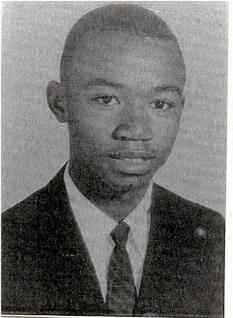
Moses Teel Jr. around the same age as Mason in As Fast As Words Could Fly
Lee & Low: In the Author’s Note, it says that you used your “typing talent to defy the prejudices of people who considered [you] inferior.” Did you also participate in a typing contest similar to the one Mason was in? What was that experience like?
Moses Teel Jr.: Yes. In my typing class, we had five-minute timed typing exercises. Five strokes counted for one word and every error took one word away from your total word count. I participated in a lot of these classroom competitions and won. That’s what helped me qualify for the tournament. By the time I had to compete, I felt pretty confident in my skill and I stayed focused by telling myself, “I can do this.”
L&L: How did you handle the hardships you encountered while at Belvoir-Falkland High School? Was there a piece of advice that you were given that inspired you? What advice would you give others who experience some form of prejudice directed toward them?
MT: The encouragement from my family and other members of the civil rights group helped me handle the hardships I faced. My dad had sacrificed a lot during the Civil Rights Movement so as to make a difference. Integrating the schools was one of the most important parts of the Civil Rights Movement in Pitt County during that time. By the time I started Belvoir-Falkland High School, I knew I had to remain humble in order to stay there. I went there for a better education, so I could make a difference in my community.
I can remember one black custodian at the school who inspired me. He would catch me and some of the few other black students outside the school to tell us that he was so proud of us for coming to that school to knock down some barriers. He told us to keep our heads up and to do the best we could.
My advice to others is to realize that prejudice does exist and you’re going to have to deal with it one on one. Just remember to stay humble and treat people the way you would like to be treated. Then you will be able to work your way through it.
L&L: Mason’s story takes place in the mid 1960s, a decade that saw the historic March on Washington, the Birmingham campaign, and the Freedom Summer of 1964. As a teenager, how strong was your sense that you were part of a greater national movement for equality?
 MT: I was well aware that we were part of a national event. During that time, we had gone to a meeting to hear Dr. Martin Luther King Jr. speak, and in part of his speech he told us to go back to our communities and make a difference. By my family being the first to integrate the school system, we felt stronger knowing that we were taking part in an integration movement that was happening all over the country.
MT: I was well aware that we were part of a national event. During that time, we had gone to a meeting to hear Dr. Martin Luther King Jr. speak, and in part of his speech he told us to go back to our communities and make a difference. By my family being the first to integrate the school system, we felt stronger knowing that we were taking part in an integration movement that was happening all over the country.
L&L: Who were your role models growing up? How did these individuals influence your actions?
MT: Two of my role models were Golden Frinks and Reginald Frazier. Golden Frinks was a field secretary for the SCLC (Southern Christian Leadership Conference). I realized how powerful Mr. Frinks was when we visited places that wouldn’t serve blacks, but after mentioning his name, attitudes changed and we were served. Reginald Frazier was a powerful attorney during that time period and I remember when he represented a black family during a racial case. The family couldn’t afford a lawyer, so he took the case for $1 and won.
These two men showed me how their determination to fight for equality could make such a difference, and how justice was more important than money. It was people like them who made me believe that with the right education, I could obtain justice in society.
L&L: When you first began at Belvoir-Falkland High School, was there anyone who surprised you with his or her kindness? Were there other African Americans who you befriended at the school or were you the only one?
MT: I’m afraid I’ll have to say no, there wasn’t, other than the black custodian. I didn’t receive much kindness from the students or faculty at Belvoir-Falkland. There were other black families who also had their children integrating during the same time, and the few of us watched out for one another. We had to stay to ourselves during physical activities because during the pick-up games we were never chosen to play with the white students. In later years, as we remained at the school, we began to be included in more activities.
L&L: Although we now have our first African American president, we still live in a country plagued by many types of inequality. How far do you think our country has come since you were a teenager in the 1960s? Where do you hope we will be ten years from now?
MT: I feel that we have improved about 70% in correcting some inequalities, but there are still a lot of hidden prejudices that have to be dealt with. I hope that ten years from now I can say we have improved 90%.
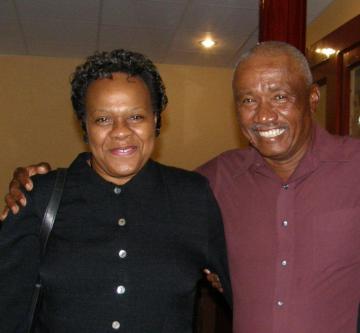
Moses Teel Jr. and his wife, Pauline Teel
Filed under:
guest blogger,
Musings & Ponderings Tagged:
African American history,
As Fast As Words Could Fly,
Civil Rights,
historical interest,
integration,
interview,
overcoming obstacles,
Pamela M. Tuck,
typewriters 


By:
keilinh,
on 9/5/2013
Blog:
The Open Book
(
Login to Add to MyJacketFlap)
JacketFlap tags:
Musings & Ponderings,
Dear Readers,
Tu Books,
DiYA,
publishing,
seoul,
Mokdong,
myeongdong,
namdaemung gate,
namdaemung market,
South Korea,
stacy whitman,
Korean food,
Korean history,
London,
kimberly pauley,
Jeju Island,
Jeonju,
Korean,
Talk to Me in Korean,
vacation,
traveling,
Buddhism,
Buddhist temple,
Cat Girl's Day Off,
Busan,
Cheonggyecheon,
Cheonggyecheon River,
Eric Yang Agency,
Gangnam,
gyungbokgung palace,
hanbok,
hanok,
hyunwoo Sun,
diversity,
Add a tag
by Stacy Whitman, Publisher of Tu Books
I had two Korean roommates in college. Ever since then, I’ve said, “Someday I will learn Korean and visit Hyun Mi in Korea.” Last year, when I made new Korean friends here in New York City, I decided that “someday” needed to finally be today. I started to learn Korean from a book and a podcast, got addicted to Korean dramas, and this May, finally made that trip to Korea I’ve been meaning to make for over a decade.
On my way to Korea, I had a 7-hour layover in London, another place I’ve never seen in person before. I got to meet Cat Girl’s Day Off author Kimberly Pauley, who showed me 221B Baker St. and the whole area around Parliament—Big Ben, the London Eye, and Westminster Cathedral, for example (the outside—no time for the inside), and then we finished off our whirlwind tour with a full English breakfast.
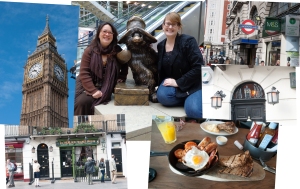
(center) Kimberly Pauley and Stacy Whitman at Paddington Station with Paddington Bear; other sights in London

A subway entrance in Busan, South Korea
I didn’t get to visit my old roommate, but I did visit my new friend from New York, who had moved back to Seoul. I stayed with her and her family in Mokdong, a suburb of Seoul, which I loved not only because I was visiting my friend, but also because I got to experience Korean culture from a closer point of view, not as a tourist in a hotel but as a guest. I got to do normal everyday things with my friend, like going to the grocery store and post office, to the bookstore and to the repair booth on the corner run by the ajussi who might know how to fix my purse (sadly, he didn’t have a good solution). I was greatly impressed with the public transportation system, which got me everywhere I needed to be, and often had malls in the stations!
I also met up with the Talk to Me in Korean crew (from whom I’m learning Korean), who happened to have a meetup when I was in Korea. Here I am with Hyunwoo Sun, the founder of Talk to Me in Korean, and his wife, Mi Kyung. A few of us went out for a kind of fusion chicken, the name of which I’ve forgotten, and then patbingsoo—sweet red beans over shaved ice—after the meetup of over a hundred TTMIK listeners.
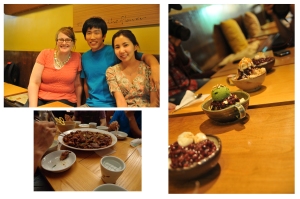
Meet-up with Talk to Me in Korean teachers and students
I love Korean dramas, which are often historical, so of course I wanted to see places like National Treasure #1, the Namdaemung Gate (officially known as Sungnyemun), which burned down in 2008 and was just recently restored and reopened, and Gyeongbokgung Palace in the heart of Seoul. The folk museum was fascinating, letting me see Korean history in person—for example, they had a living replica of a Korean street that brought you forward in time from the Joseon era to the 1990s.
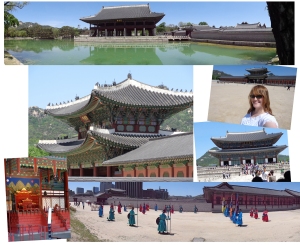
Gyeongbokgung Palace, Seoul, South Korea
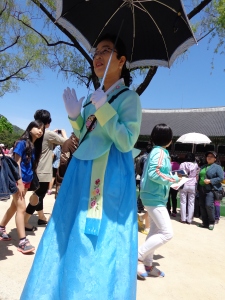
A tour guide at Gyeongbokgung Palace wearing a hanbok, a traditional Korean dress
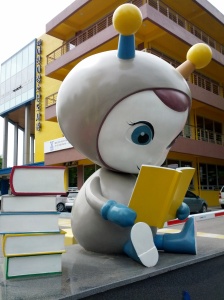
Outside the National Children’s Library in Gangnam, Seoul, South Korea
I also went to the Namdaemun Market, across from the gate, and had my first real Korean market experience, and found a stylish purse. I rode a bike along the Han River (and saw cleverly disguised trash/recycling cans), discovered the national children’s library in Gangnam, watched the changing of the guards at Gyeongbokgung Palace, stopped off for a chocobanana smoothie at Starbucks for a quick wifi fix, wandered around in a park filled with fortune teller booths, got makeup samples in Myeongdong, and found bargains in an underground shopping mall at the subway entrance. What I didn’t do was stalk a Korean drama star, though that was tempting. 

Cleverly disguised recycling

Cheonggyecheon River, Seoul, South Korea
Not too far from the palace was the Cheonggyecheon River, which is a reclaimed river that has been turned into a recreational area. It was my favorite area of Seoul—I loved to walk along it and returned three times while on my way to other places. The first time I discovered it (on the recommendation of Korean American library educator and friend Sarah Park Dahlen), it was decorated for Buddha’s Birthday, a national holiday in Korea. The next day, on Buddha’s Birthday, my Korean host and I went to the local Buddhist temple to discover how the holiday was celebrated among Buddhists, which neither of us are. That night, the Cheonggyecheon was all lit up in celebration.

Stacy Whitman at the Buddhist temple in Mokdong, South Korea

Cheonggyecheon River, Seoul, South Korea

Beomosa Temple, Busan, South Korea
I spent a total of two weeks exploring Korea, the second week of which was spent climbing a mountain on Jeju Island, discovering a Buddhist temple and a famous beach and fish market in Busan, and staying in a hanok (traditional Korean house) in Jeonju—where I also happened upon a famous Joseon picnic spot (Omokdae Terrace, famous for a king having once picnicked there), a famous royal shrine, and a Confucian school where one of my favorite dramas was filmed, and where I saw a delightful sight, a class full of toddlers in hanbok, learning about their country’s history. Jeonju also is the home of a traditional Korean paper (hanji) museum, where they have a hands-on room where I made a sheet of hanji! Later I met the driver of a truck full of garlic, who insisted I take a picture of his truck.
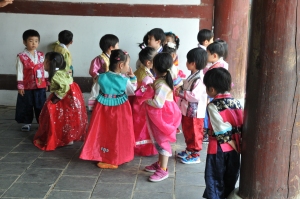
Schoolkids at Jeonjuhyanggyo Confucian School in Jeonju, South Korea

Truck full of garlic in Jeonju, South Korea
Then I rounded out the experience with my friend’s one-year-old’s birthday party in Seoul. (The first birthday is very important in Korean culture, a momentous occasion for which my friend and her husband rented hanbok to wear for family pictures, which I took for them.) However, I didn’t get to the top of 9 km-high Hallasan, the big mountain in Jeju (though I made it 7.5 km!), as I didn’t start early enough in the morning. I’ll just have to go back. Oh darn! (I did, however, get the rare opportunity to see a native deer.)
I ate loads of delicious Korean food, most of which was homemade by my host family, but I also discovered new foods like Jeju’s famous gogiguksu, a pork noodle dish very similar to good ramen. I also had the chance to try Koreans’ interpretation of Italian food, which is very popular—and was very tasty.

(clockwise from upper left) Korean street food in Busan, kimbap in Seoul, pizza in a cone & smoothie in Jeonju, Italian food in Jeonju
And I took a break from my vacation one day to work, because you can’t publish diverse books and travel halfway around the world and not take the opportunity to meet publishers in the country you’re so interested in. An agent at the Eric Yang Agency was happy to introduce me to several Korean publishers, who were happy to introduce me to their books and to learn about mine. Here’s a picture of the mural in their lobby, a testament to the love of reading in Korean culture and a great riff on the famous photo.

Lunch atop a Skyscraper, now with books!
It was interesting to see how similar and yet different the two country’s publishing styles were—often, we publish similar books, yet we market them completely differently because Korean parents/readers and American parents/readers are looking for different marketing messages in the books they buy. Young adult literature as a category is still relatively new in Korea, particularly in fantasy (though the age category’s storytelling is strong in dramas and manhwa, the Korean form of manga)—the emphasis in Korean children’s book sections of the bookstore is very much on educational supplements. I look forward to someday bringing Korean YA and middle grade voices to a US audience looking for diversity and new stories.
* And it was a bear trying to pare down my pictures. If you’d like to see more, follow me on Tumblr, where I will eventually be posting more pictures a few at a time.
Filed under:
Dear Readers,
DiYA,
Musings & Ponderings,
Tu Books Tagged:
Buddhism,
Buddhist temple,
Busan,
Cat Girl's Day Off,
Cheonggyecheon,
Cheonggyecheon River,
diversity,
Eric Yang Agency,
Gangnam,
gyungbokgung palace,
hanbok,
hanok,
hyunwoo Sun,
Jeju Island,
Jeonju,
kimberly pauley,
Korean,
Korean food,
Korean history,
London,
Mokdong,
myeongdong,
namdaemung gate,
namdaemung market,
publishing,
seoul,
South Korea,
stacy whitman,
Talk to Me in Korean,
traveling,
vacation 


By:
keilinh,
on 3/20/2013
Blog:
The Open Book
(
Login to Add to MyJacketFlap)
JacketFlap tags:
Holidays,
poetry,
seasons,
flowers,
spring,
green,
growth,
Children's Book Press,
Musings & Ponderings,
Art,
Celebrations,
Add a tag
While it may not feel like it, today is the first day of spring! We’re very excited for our forthcoming spring titles, which you can check out here. To kick off the spring season, here’s an image and poem from Laughing Tomatoes and Other Spring Poems/Jitomates Risueños y otros poemas de primavera, written by Francisco X. Alarcón, and illustrated by Maya Christina Gonzalez, published by Children’s Book Press, an imprint of LEE & LOW.
Spring
the hills
are starting
to crack
a green smile
once again
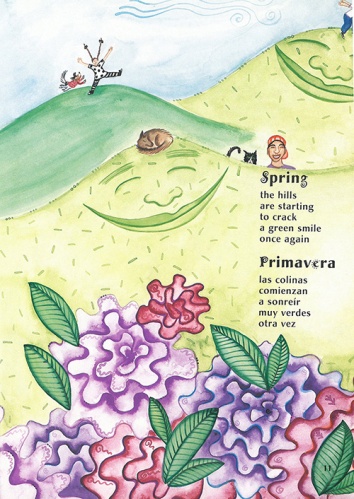
Primavera
las colinas
comienzan
a sonreír
muy verdes
otra vez
Filed under:
Art,
Celebrations,
Holidays,
Musings & Ponderings Tagged:
Children's Book Press,
flowers,
green,
growth,
poetry,
seasons,
spring 


By:
keilinh,
on 3/12/2013
Blog:
The Open Book
(
Login to Add to MyJacketFlap)
JacketFlap tags:
writing contests,
diversity,
guest blogger,
Science Fiction/Fantasy,
Power of Words,
Musings & Ponderings,
Race issues,
Tu Books,
Teens/YA,
promoting diversity,
New Visions Award,
Add a tag
 In January we announced the finalists of our first New Visions Award, a new writing award for a debut author of color for a middle grade or young adult science fiction, fantasy, or mystery novel. Over the last few weeks, we’ve highlighted these talented finalists on our blog as they answer questions about what inspires them, the writing process, and more. Perhaps among these five finalists you’ll find your next favorite author!
In January we announced the finalists of our first New Visions Award, a new writing award for a debut author of color for a middle grade or young adult science fiction, fantasy, or mystery novel. Over the last few weeks, we’ve highlighted these talented finalists on our blog as they answer questions about what inspires them, the writing process, and more. Perhaps among these five finalists you’ll find your next favorite author!
Previously, our New Visions finalists shared their experiences as young readers, and whether they saw themselves represented in books.
In this last post, they share their final thoughts on diversity in genre fiction for middle grade and young adult readers:
Ailynn Knox-Collins
I applaud the efforts that publishers like Tu Books are making to bring diversity into children’s lite rature. I am humbled and grateful to have been given a small part to play here. I may not ever be published but I will always be writing and will most certainly be a reader for the rest of my life. As a teacher of children from all over the world, I am excited to introduce them to a new stage of diversity in books, where they may find themselves reflected in the stories.
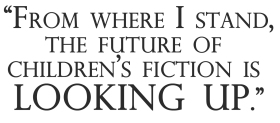 From where I stand, the future of children’s fiction is looking up. They will see more and more books where the covers feature people like them, of all races and creeds, beliefs and lifestyles. Everyone will have a chance to be a hero and every reader will find a place for themselves in the thrilling worlds of mystery, fantasy and science fiction. I can’t hide the huge smile on my face because the child in me is thrilled. I am so proud to be a part of this movement. I hope more writers of color will be encouraged to write from their cultural backgrounds and enrich the book world with new ideas. It wouldn’t surprise me that although the names and settings have been changed, in the end, we’ll discover that there is much that we share with each other; that we have more in common than we realize.
From where I stand, the future of children’s fiction is looking up. They will see more and more books where the covers feature people like them, of all races and creeds, beliefs and lifestyles. Everyone will have a chance to be a hero and every reader will find a place for themselves in the thrilling worlds of mystery, fantasy and science fiction. I can’t hide the huge smile on my face because the child in me is thrilled. I am so proud to be a part of this movement. I hope more writers of color will be encouraged to write from their cultural backgrounds and enrich the book world with new ideas. It wouldn’t surprise me that although the names and settings have been changed, in the end, we’ll discover that there is much that we share with each other; that we have more in common than we realize.
Valynne E. Maetani
Somewhere out there are children just like me. They use reading as a way to escape life’s obstacles. They enjoy being sucked into magical worlds that challenge their imaginations. Sometimes books help them realize their problems are not as bad as they seem. They realize through characters that difficulties are a part of the human experience, but there are others like them who feel and react the same way they do.
In other ways, those same children might be not like me. They are children who might know little about Japan and its foods or customs. They may not have any idea what’s it’s like to grow up Japanese-American or understand how deep-rooted our traditions are.
For all children, books are a way of making connections and allowing them to experience something new. Diversity in middle grade and young adult literature enriches the reading experience by increasing the breadth and depth of what our children have access to, and because of this, there is also an increased chance for children to connect and learn. Both characters and authors of color can provide an introduction to unique perspectives. I find that most intolerance stems from a lack of understanding, and books are one forum which can equip children with information. I’m not naïve enough to think diversity in genre fiction will change everything, but every time we connect with a child, we open doors, and that makes writing worth it.
Rahul Kanakia
In any discussion of diversity, the shadow constituency is white people. Obviously, it’s really nice for teens of color to see depictions of themselves in the media that they consume. But unless those depictions also appeal in some way to white people, then those depictions will not get the major play 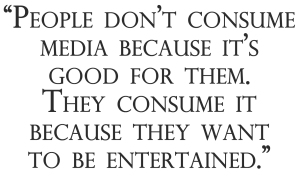 that they need in order to be published and widely distributed in a way that makes sure they get into the hands of people of color.
that they need in order to be published and widely distributed in a way that makes sure they get into the hands of people of color.
And, of course, we all know that it’s good for white people to see the diversity of the world. But that also doesn’t matter. People don’t consume media because it’s good for them. They consume it because they want to be entertained.
So the challenge is to create depictions of PoC that are also entertaining to white people. It’s hard. And it’s often a bit unsatisfying. Writing for an outsider audience means including explanations and “authentic” detail that insiders don’t necessarily need, or want, to see. And if you veer too much in that direction, then you alienate people of your own culture. And that alienation can often be good business, actually, because those people are actually just a tiny fraction of your audience and in terms of getting fame and book sales it makes a lot more sense to feed the preferences of a white audience that hungers for PoC characters who hang around in this tiny sweet spot where they’re alien enough to be picturesque but also relatable enough that they don’t pose a serious challenge to majority culture.
Akwaeke Emezi
I’m curious about what effect it would have had on me as a child and young adult to have had access to more fiction with characters that looked like me, or that came from cultures that I could have related to with more ease. I’ll never know, but I believe that kids nowadays should definitely have access to all that material and I am grateful for all those who are working to make this happen.
Disclaimer- I’m not very immersed in the writer world so this conversation is somewhat new to me. However, it seems to me that diversity in genre fiction (or the lack thereof) is essentially a race issue- who is considered the default race and the limited range of cultures, descriptions, etc that spring forth from that. It’s just not representative of the real world and it does people and children of color a disservice. Stories help people relate to whatever they’re reading about- I had no problem as a child believing that pixies lived in my compound or imagining that the tree in our backyard was The Faraway Tree even though all Enid Blyton characters were white. All children (all people, actually) would benefit greatly from having access to diverse fiction and being exposed to different cultures and people.
Ibi Zoboi
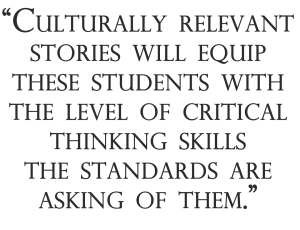 I teach in New York City public schools as a writer-in-residence. So I have a pretty good idea of what inner city children and teens are dealing with in terms of literacy. These new Common Core Learning Standards are asking students to read broadly and deeply—more informational nonfiction texts. And part of my job entails listening to teachers complain how this is a huge leap for many of their students. They’re being asked to argue these complex ideas and think critically, yet they have very little sense of themselves, their world and their place in it.
I teach in New York City public schools as a writer-in-residence. So I have a pretty good idea of what inner city children and teens are dealing with in terms of literacy. These new Common Core Learning Standards are asking students to read broadly and deeply—more informational nonfiction texts. And part of my job entails listening to teachers complain how this is a huge leap for many of their students. They’re being asked to argue these complex ideas and think critically, yet they have very little sense of themselves, their world and their place in it.
When I teach fiction in places like Brooklyn and the Bronx, I’d get so many blue-eyed, blonde-haired characters in these stories you’d think we were in Norman Rockwell’s America. They’re emulating what they have to read. Reading the classics is a good thing. But culturally relevant stories will equip these students with the level of critical thinking skills the standards are asking of them. A great number of sci-fi classics can be paired with well-written YA dystopian novels, for example. And what if they can see themselves and their culture in these books? Orwell’s 1984 then becomes that much more relevant.
Underrepresented students who experience school closures, substandard housing, and violence need to be able to think critically about a genre MG or YA novel and how it relates to them. They need to see themselves taking center stage in heroic stories before they can begin to affect change in their own communities.
Further Reading:
Meet Our New Visions Finalists I: How we got involved in the New Visions Award
Meet Our New Visions Finalists II: How we got involved in the New Visions Award
Meet Our New Visions Finalists III: Writing for people of different backgrounds
Meet Our New Vision Finalists IV: Your relationship to books as a young reader
Filed under:
guest blogger,
Musings & Ponderings,
Tu Books Tagged:
diversity,
New Visions Award,
Power of Words,
promoting diversity,
Race issues,
Science Fiction/Fantasy,
Teens/YA,
Tu Books,
writing contests 


By:
Amanda,
on 3/5/2013
Blog:
The Open Book
(
Login to Add to MyJacketFlap)
JacketFlap tags:
Awards,
writing contests,
diversity,
guest blogger,
Science Fiction/Fantasy,
Power of Words,
Musings & Ponderings,
Race issues,
Tu Books,
Teens/YA,
promoting diversity,
New Visions Award,
Add a tag
 In January we announced the finalists of our first New Visions Award, a new writing award for a debut author of color for a middle grade or young adult science fiction, fantasy, or mystery novel. Over the next few weeks, we’ll be highlighting these talented finalists on our blog as they answer questions about what inspires them, the writing process, and more. Perhaps among these five finalists you’ll find your next favorite author!
In January we announced the finalists of our first New Visions Award, a new writing award for a debut author of color for a middle grade or young adult science fiction, fantasy, or mystery novel. Over the next few weeks, we’ll be highlighting these talented finalists on our blog as they answer questions about what inspires them, the writing process, and more. Perhaps among these five finalists you’ll find your next favorite author!
Previous posts by our New Visions finalists:
Q: What was your relationship to books and reading as a child or teenager? In what ways did you see yourself represented in books?
Ailynn Knox-Collins
I was seven when I attended my first boarding school. Determined to hate the experience, I succeeded at being miserable. Over the next few years, I changed school six times. I was always the new kid, but I wasn’t the nice one. I got into fights, defied teachers and even started a gang to beat up boys (I didn’t actually beat up anyone). Adults whispered about me when they thought I wasn’t listening. I was the poor child whose parents were getting a divorce. Because of that, I got away with everything which just made me more miserable.
Then one day, a teacher introduced me to CS Lewis and his worlds brought a spark into my self-imposed misery. Books became my escape. I devoured every story, mostly fantasy at first. I began to write as well, putting myself in places where I could be somewhere or someone else. Meeting Austen, Hardy and the Bronte sisters began my love affair with classical English literature. Those were wonderful years. Finally, Asimov came along and that opened the world of science fiction to me. Life became hopeful even while aliens were invading and snatching bodies, because the heroes always triumphed. And that’s where I kept seeing myself, whether or not the characters looked like me or spoke like me. They came out on top at the end and in my darkest moments, that was what I needed the most.
Ibi Zoboi
I was one of those statistical kids who did not own books. My mother worked two jobs to send me to Catholic school and we lived in a part of Brooklyn where little girls did not skip to the library on their own. We did own encyclopedias, though, but not novels and picture books. This had more to do with culture rather than economics. For students in Haiti, reading was more for rote memorization of textbooks. That’s what my mother made me do with the encyclopedias.
I was dealing with some  serious identity issues by the time I got to high school. We’d moved to suburban Queens and I went to a mostly white Catholic high school. I desperately wanted mirror stories but I’d settled on having some sort of movie star idol instead. Halle Berry was just starting out then and she had starred in the TV movie Alex Haley’s Queen. That’s what led me to reading the actual book. Then I read Alex Haley’s Roots and looked for other titles in that section of my high school’s library—slave narratives (which at some point led me to Octavia Butler’s Kindred). Then I got mad at the world and worked in a bookstore all throughout college and read everything I could afford on my employee discount (RIP Waldenbooks).
serious identity issues by the time I got to high school. We’d moved to suburban Queens and I went to a mostly white Catholic high school. I desperately wanted mirror stories but I’d settled on having some sort of movie star idol instead. Halle Berry was just starting out then and she had starred in the TV movie Alex Haley’s Queen. That’s what led me to reading the actual book. Then I read Alex Haley’s Roots and looked for other titles in that section of my high school’s library—slave narratives (which at some point led me to Octavia Butler’s Kindred). Then I got mad at the world and worked in a bookstore all throughout college and read everything I could afford on my employee discount (RIP Waldenbooks).
It all started with wanting to see an image of beauty and success that was real to me. Halle’s hair was short and she was black and she’d been a heroine. I don’t think I would’ve been so superficial if I’d seen some of those images in books as a child.
Rahul Kanakia
My mom gave me Isaac Asimov’s Foundation when I was around 10 years old. She’d first read it as a kid in Mumbai in the 1960s. I loved the book’s thought-provoking premise and epic scope and I knew that I wanted more of that. Until I went to college, I only read science fiction and fantasy novels: mostly hard science fiction, space operas, military SF, epic fantasy, and swords and sorcery.
All of these subgenres are largely comprised of adventure stories. They’re about heroes who triumph over tremendous obstacles. And, because I read hundreds and hundreds of these books, I wanted to grow up and become a hero. Many SF fans of color go through a period of disillusionment when they realize that the genre doesn’t care to represent them. That did not happen to me. For whatever reason, I had no trouble identifying with the square-jawed white protagonists.
My disillusionment arose when I realized that heroism is a bit of a sham. It doesn’t exist in real life. Or, at least, not in the way that they write about it in the stories. Of course, everyone realizes that eventually. And, after growing up, some people are still able to find value in the metaphor: the hero represents some spiritual transcendence or state of striving. But I was never able to get over my disappointment. To this day, I find it difficult to read a traditionally-structured SF novel.
Valynne E. Maetani
In the third grade, I skipped recess so that I could read a series of non-fiction books. Each detailed the life of someone famous in history. Only one of those books was about a woman: Marie Curie.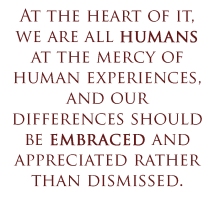 Shewas smart and brave, and I wondered if I could ever be like her. Often, my father would surprise me with books. Each had strong female characters like those in Little Women or The Good Earth. In our Asian culture, where emotions are rarely exposed, this was his way of telling me that he believed I could be brave and strong like Madame Curie, the March women, or O-Lan.
Shewas smart and brave, and I wondered if I could ever be like her. Often, my father would surprise me with books. Each had strong female characters like those in Little Women or The Good Earth. In our Asian culture, where emotions are rarely exposed, this was his way of telling me that he believed I could be brave and strong like Madame Curie, the March women, or O-Lan.
At some point, I fell in love with mysteries, devouring Encyclopedia Brown and eventually books by Agatha Christie. Yet I realized there were rarely characters of color. So a few years ago I decided to write a book for my youngest sister’s eighteenth birthday. I had a vague idea of the storyline but knew it would be a mystery; the protagonist would be a strong young woman; and she and her family would be Japanese. What I wanted to share through my writing is that as much as we try to fit in with those around us, we will always be different. I realized, once I was older, that being different is the precise thing my friends loved about me and my family. At the heart of it, we are all humans at the mercy of human experiences, and our differences should be embraced and appreciated rather than dismissed.
Akwaeke Emezi
My relationship to reading has always been a huge part of my life and luckily, both my parents were avid readers who happily loaded me up with books. I read everything I could find; my favorites were authors like Lewis Carroll, Kipling, James Herriot, Enid Blyton, C.S. Lewis, J.K. Rowling, etc. I also rea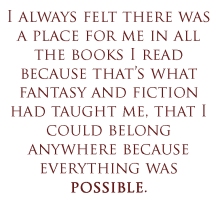 d several classics as a child/teen simply because they were in my house and I needed things to read: Anna Karenina, Crime and Punishment, The Odyssey, A Tale of Two Cities, etc. I remember reading Flowers in the Attic before I was ten…that was quite an experience!
d several classics as a child/teen simply because they were in my house and I needed things to read: Anna Karenina, Crime and Punishment, The Odyssey, A Tale of Two Cities, etc. I remember reading Flowers in the Attic before I was ten…that was quite an experience!
I was always reading at the dinner table, at school while on break, by candlelight because the power was always out, in the bathroom- I was insatiable and churned through books quickly. We had an outdoor book market at the Post Office in my town in Nigeria, where you could bring second hand books and swap them out for more, which was a great resource.
As a child/teen, I always felt there was a place for me in all the books I read because that’s what fantasy and fiction had taught me, that I could belong anywhere because everything was possible.
Further Reading:
Meet Our New Visions Finalists I
Meet Our New Visions Finalists II
Meet Our New Visions Finalists III
Filed under:
Awards,
guest blogger,
Musings & Ponderings,
Tu Books Tagged:
diversity,
New Visions Award,
Power of Words,
promoting diversity,
Race issues,
Science Fiction/Fantasy,
Teens/YA,
writing contests 


By:
keilinh,
on 2/28/2013
Blog:
The Open Book
(
Login to Add to MyJacketFlap)
JacketFlap tags:
biography,
nonfiction,
painting,
black history month,
slavery,
don tate,
overcoming obstacles,
Musings & Ponderings,
It Jes' Happened,
bill traylor,
dreams and aspirations,
African American interest,
united states history,
Add a tag
Everyone knows Frederick Douglass and Martin Luther King, Jr., but there are many other African Americans who have contributed to the rich fabric of our country but whose names have fallen through the cracks of history.
We’ve asked some of our authors who chose to write biographies of these talented leaders why we should remember them. We’ll feature their answers throughout Black History Month.
Today, Don Tate shares why he wrote about Bill Traylor in It Jes’ Happened: When Bill Traylor Started to Draw:
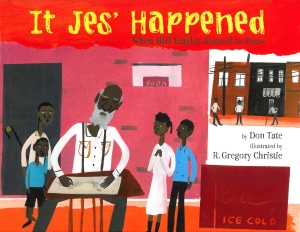
Bill Traylor was an “outsider artist.” He learned to draw in much the same way that I learned to paint: by trial and error. He taught himself to draw. Somehow I felt an immediate kinship to Bill. In his day, Bill’s art sold for about 10- to 25-cents and was panned by art critics as “primitive.” Today Bill’s art is collected by top art connoisseurs, and is on display in museums all over the world, selling for thousands of dollars. I love these kinds of stories where the “outsider” gets the glory.
Bill had an inborn – I believe God-given – talent that came forth in time of great need. That spoke to me, too. It supported my belief that all people are born equipped with everything needed to overcome great obstacles in life and do great things.

I think it’s important for children to be exposed to a variety of historical figures. Black history is not limited to the one or two people that are so often written and published about. In addition to civil rights, African Americans have made great contributions to science and technology, arts and literature, sports and entertainment, education and business. Bill Traylor was an artist, but he was also a journalist, though he may not have realized it. And a historian, too.Through his art, he documented an important part of American history that will be appreciated for many hundreds of years to come.
Further reading:
Black History Month: Why Remember Florence “Baby Flo” Mills?
Black History Month: Why Remember Robert Smalls?
Black History Month: Why Remember Toni Stone?
Black History Month: Why Remember Arthur Ashe?
Black History Month Book Giveaway
Filed under:
Musings & Ponderings Tagged:
African American interest,
bill traylor,
biography,
black history month,
don tate,
dreams and aspirations,
It Jes' Happened,
nonfiction,
overcoming obstacles,
painting,
slavery,
united states history 


By:
keilinh,
on 2/26/2013
Blog:
The Open Book
(
Login to Add to MyJacketFlap)
JacketFlap tags:
Science Fiction/Fantasy,
Power of Words,
Musings & Ponderings,
Race issues,
cultural diversity,
Tu Books,
Teens/YA,
New Visions Award,
different cultures,
Awards,
writing contests,
diversity,
writing,
Add a tag
 Last month we announced the finalists of our first New Visions Award, a new writing award for a debut author of color for a middle grade or young adult science fiction, fantasy, or mystery novel. Over the next few weeks, we’ll be highlighting these talented finalists on our blog as they answer questions about what inspires them, the writing process, and more. Perhaps among these five finalists you’ll find your next favorite author!
Last month we announced the finalists of our first New Visions Award, a new writing award for a debut author of color for a middle grade or young adult science fiction, fantasy, or mystery novel. Over the next few weeks, we’ll be highlighting these talented finalists on our blog as they answer questions about what inspires them, the writing process, and more. Perhaps among these five finalists you’ll find your next favorite author!
Q: What has been your experience writing from a different cultural background that may be unfamiliar to most young readers?
Ibi Zoboi, Haiti.
While most readers are familiar with Edwidge Danticat, there are, of course, other Haitian and non-Haitian writers telling stories about Haitian children. M. Sindy Felin’s Touching Snow was a National Book Award Finalist. The recent winner of the Printz Award is In Darkness, a story about a Haitian boy during the earthquake written by Nick Lake. One of my favorite Haitian YA books is Taste of Salt by the late Frances Temple.
Haiti has an amazing literary tradition and under a brutal dictatorship, writers either risked their lives or were sent into exile. So, for me, writing about Haiti is very political. Though, my stories are cloaked in a world of magic. What better way to convey Haiti’s complex history and mythology than in a young adult fantasy novel? This simply adds another layer of depth to what young readers already know about Haiti, or any given culture. They must know that culture is multi-dimensional and is not regulated to the superficial “facts” in the media. This is why mythology breathes life into everything I write. While the names and magical systems differ, there is an interconnecting power in world mythology that can resonate with any reader.
Ailynn Knox-Collins, Earth.
I’ve lived in six countries and been a citizen of three, so it’s hard to decide where my origins lie. I immersed myself into the language and culture of each of the lands that have housed me and made me feel welcome. Yet, I belong to none in particular. Many people live in a culture different from their ancestors or like me, have ancestors from all over. We learn to hang on to the crucial values and adapt to others within our environment.
As a child, for example, I learned to ‘chameleon’ my accent simply to fit in. I write to discover who I am and I believe I’m not alone in this journey. In my books, I place my characters in almost sterile environments just to see what happens, so what is truly important can bubble to the surface. It seems appropriate in my form of science fiction, where the story is set in space, and humanity must rebuild itself by deciding what to keep and what to leave behind. I pepper the stories with values and beliefs I’ve picked up on the way, hoping that many of these are universal, since in the end, we are all but citizens of this one tiny planet.
Valynne E. Maetani, Japan.
Though I am fourth-generation pure Japanese, there were many traditions that my family maintained. As a child, I removed my shoes before I entered the house, ate certain kinds of foods on holidays, and threw salt over my shoulder on New Year’s Day. But I had no idea why we did the things we did. For me, writing about the Japanese culture has been a way of sharing and understanding the meaning and purpose behind the traditions.
I like writing for young adults because it’s an age where kids no longer do things just because their parents tell them to. It’s an age where they begin to question why on a much deeper level. In order for traditions to be preserved, I think it’s important to first understand the why and the rich history behind those traditions and second, important to share that knowledge with others.
Rahul Kanakia, India.
There is a lot of literature about the Indian diasporic experience. And, when I was around fourteen years old, I went through a phase where I read a fair amount of it.
And I hated it.
The standard Indian immigrant narrative is about the angst and the pain of being trapped between worlds. It is about attempting to assimilate and finding that assimilation was impossible. It is about attempting to recover an Indian cultural identity and finding that to be impossible as well. It is, fundamentally, about always feeling alone in the world. Kind of a grim future to outline for a fourteen year old who just wants to, you know, experience the world and make friends and write books and be happy.
So I try to write stories where Indian protagonists aren’t oppressed by their heritage. I think part of the reason I like writing science fiction is that in an SF novel, there’s always something else going on. You might be struggling to fit in…but you’re also struggling to fight off the zombie hordes.
Akwaeke Emezi, Nigeria + Malaysia.
My cultural background is blended- I was born in Nigeria and lived there until I left for college, so I identify very strongly with being Igbo. I was also raised with my mother’s Malaysian culture, so although I can’t cook Nigerian food to save my life, I tie my own saris, wear jade, and ritually stockpile Baba’s Curry Powder. However, moving to the States brought my nationality to the foreground as an immigrant, and that was when I realized how much growing up in Nigeria impacted my identity.
I deliberately reached for what felt like home and birthright while I was writing Somadina. I was born where my father was born and his father before him, so I constructed a fantasy world around Igbo culture and traditional religion. Other than Nnedi Okorafor’s delightful work, I hadn’t seen my culture represented in speculative fiction, so I saturated this story in it.
I also write from different points of myself outside of my ethnicities, but elements of my cultures often seep through in a name/food/phrase. After all, where I come from shapes who I am now, with half a body in the otherworld, stories coming through my teeth, and all.
Further Reading:
What brought our New Visions finalists to Tu Books and to the New Visions Award competition in particular?
Ailynn and Valynne answer
Ibi, Rahul, and Akwaeke answer
Filed under:
Awards,
Musings & Ponderings,
Tu Books Tagged:
cultural diversity,
different cultures,
diversity,
New Visions Award,
Power of Words,
Race issues,
Science Fiction/Fantasy,
Teens/YA,
Tu Books,
writing,
writing contests 


By:
Hannah,
on 2/25/2013
Blog:
The Open Book
(
Login to Add to MyJacketFlap)
JacketFlap tags:
awards,
american library association,
black history month,
Resources,
guest blogger,
Why I Love Librarians,
African American history,
African/African American Interest,
coretta scott king awards,
Musings & Ponderings,
Publishing 101,
Add a tag
In this guest post, Dr. Henrietta M. Smith, Professor Emerita and the first African-American professor at the University of South Florida, School of Information shares her memories of how the Coretta Scott King Award began:
The news of the damage sustained by the boardwalk in Atlantic City during Hurricane Sandy brought back memories of where the Coretta Scott King Award started. This writer’s mind went back to an earlier time, to an American Library Association annual meeting in Atlantic City. 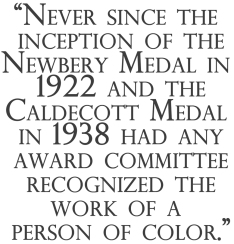 The year was 1969. Two librarians walking through the exhibit hall stopped by a booth where a poster of the late Martin Luther King Jr. was on display. This was the start of a genial conversation that evolved into the observation that never since the inception of the Newbery Medal in 1922 and the Caldecott Medal in 1938 had any award committee recognized the work of a person of color.
The year was 1969. Two librarians walking through the exhibit hall stopped by a booth where a poster of the late Martin Luther King Jr. was on display. This was the start of a genial conversation that evolved into the observation that never since the inception of the Newbery Medal in 1922 and the Caldecott Medal in 1938 had any award committee recognized the work of a person of color.
John Carroll, a publisher from a small company in New York, overheard the conversation. It was reported that he said, rather matter of factly, “Then why don’t you ladies establish your own award?” The seed was planted. Before the conference ended, in an informal meeting on the boardwalk in Atlantic City under the leadership of Glyndon Greer and Mabel McKissick, the idea of a award for African American authors was shared with a group of African American librarians, including Augusta Baker, Charlemae Rollins, Ella Mae Yates, and Virginia Lacy Jones, to name a few. At this seaside gathering, the struggle for recognition began.
 The ALA questioned the need for another award. A majority of publishers informed the committee that they did not have enough children’s books by African Americans to provide for evaluation. And many librarians were skeptical of anything becoming of this fragile brainchild. Undaunted and unconvinced that this venture was fruitless, the committee moved on. In 1970, the first Coretta Scott King Awards breakfast was scheduled in a hotel that just “happened” not to be on the ALA list of official hotels. After a meager meal and short program, the first recipient of the Coretta Scott King Award was announced. A school librarian from New Jersey, Lillie Patterson, went down in history as the first winner of the award for her elementary level biography, Martin Luther King, Jr.: Man of Peace.
The ALA questioned the need for another award. A majority of publishers informed the committee that they did not have enough children’s books by African Americans to provide for evaluation. And many librarians were skeptical of anything becoming of this fragile brainchild. Undaunted and unconvinced that this venture was fruitless, the committee moved on. In 1970, the first Coretta Scott King Awards breakfast was scheduled in a hotel that just “happened” not to be on the ALA list of official hotels. After a meager meal and short program, the first recipient of the Coretta Scott King Award was announced. A school librarian from New Jersey, Lillie Patterson, went down in history as the first winner of the award for her elementary level biography, Martin Luther King, Jr.: Man of Peace.

from Ray Charles
It was not until 1974 that the award breakfast was held in an ALA conference site, but even then, the CSK Award was not recognized as an official ALA award, nor was the award committee recognized as an official ALA body. But to the joy of all, publishers were now sending more quality books, and attendance at the 7:30 a.m. breakfast was steadily growing! Another change came in 1974 when the committee presented its first illustrator award. George Ford, who is still painting today, won for the illustrations he created for Sharon Bell Mathis’ biography Ray Charles.
In the years that followed, a major breakthrough came when E. J. Josey was elected president of the ALA. One of his first concerns was to bring the Coretta Scott King Committee into the official folds of the American Library Association. In 1980, the Coretta Scott King Committee became the Coretta Scott King Task Force, a viable part of Social Responsibilities Task Force (since 1993 a part of EMIERT), with founder Glyndon Greer as its first chair.
Growth and changes can be seen as the benchmark of this dynamic group of librarians. Artist Lev Mills designed the medal that is placed on each award-winning book. The symbols in the medal’s design each carry a special message; even the colors of the winner and honor book medals, and the more recent new talent award medal, have significance. The monetary prize for the winners was first given through the efforts of the late Basil O. Phillips of the Johnson Publishing Company, and today the encyclopedias from Britannica and World Book have moved from print into the digital age.
Following negotiations with the ALA parent body on Awards and Recognitions, and the late John Steptoe’s son, illustrator Javaka Steptoe, in 1995, the New Talent Award was established. It was named in honor of John Steptoe, whose first book, Stevie (1969), won national acclaim when the author/illustrator was only nineteen years of age.
With each meeting of the Coretta Scott King Task Force, new ideas for growth are on the docket. Among the newest is the Coretta Scott King/Virginia Hamilton Award for Lifetime Achievement, which goes to an African American author, illustrator, author/illustrator, or practitioner (such as a librarian) for his or her body of work or contributions to reading programs involving African American literature. Changes are constantly in the works too. New ideas for creating greater visibility and wider use of Coretta Scott King Award books and materials are a part of every Task Force meeting.
To think that all this started with a meeting on the boardwalk in Atlantic City! The very spot may not be there now, but surely the news reports about Hurricane Sandy conjured up many of these same memories for those who met on the boardwalk way back in 1969.
Dr. Henrietta M. Smith, native New Yorker, received her MLS degree from Columbia University and EdD from University of Miami, Florida. She teaches in the Materials for Youth in the School of Information (University of South Florida, Tampa, Florida). Longtime member of the ALA, Smith has served on Newbery Caldecott, Wilder (Chair), and Pura Belpré Award committees for ALSC and has chaired the Coretta Scott King Task Force and the CSK Award Committee. Smith received the ALSC Distinguished Service Award in 2008 and in 2011 was the first practitioner recipient of the Coretta Scott King/Virginia Hamilton Award for Lifetime Achievement in Librarianship.
Filed under:
guest blogger,
Musings & Ponderings,
Publishing 101,
Resources Tagged:
African American history,
African/African American Interest,
american library association,
awards,
black history month,
coretta scott king awards,
Why I Love Librarians 


By:
Amanda,
on 2/20/2013
Blog:
The Open Book
(
Login to Add to MyJacketFlap)
JacketFlap tags:
Science Fiction/Fantasy,
Power of Words,
Musings & Ponderings,
Race issues,
Tu Books,
Teens/YA,
New Visions Award,
Awards,
writing contests,
diversity,
Add a tag
 Last month we announced the finalists of our first New Visions Award, a new writing award for a debut author of color for a middle grade or young adult science fiction, fantasy, or mystery novel. Over the next few weeks, we’ll be highlighting these talented finalists on our blog as they answer questions about what inspires them, the writing process, and more. Perhaps among these five finalists you’ll find your next favorite author!
Last month we announced the finalists of our first New Visions Award, a new writing award for a debut author of color for a middle grade or young adult science fiction, fantasy, or mystery novel. Over the next few weeks, we’ll be highlighting these talented finalists on our blog as they answer questions about what inspires them, the writing process, and more. Perhaps among these five finalists you’ll find your next favorite author!
Q: What brought you to Tu Books and to the New Visions Award competition in particular?
Rahul Kanakia, Baltimore, MD:
My novel has a number of autobiographical elements. I mean, obviously, I didn’t grow up in a plague-wracked authoritarian dystopia, but I did share many of the troubles and experiences of the character in my novel. I went to Catholic school and I was confused regarding my sexual orientation and I had body image issues. And when I started the first draft of my very first YA novel, all of that came out of me in a crazy rush. Nothing was filtered. Everything was on the paper. Never before nor since have I experienced that kind of pure mind to keyboard translation.
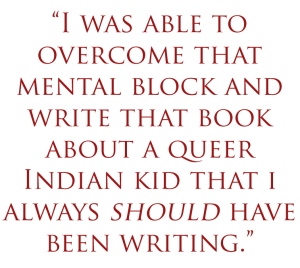 Except for one thing. The protagonist of that first draft was white. That’s because (kind of funnily, since I’m currently enrolled in an MFA program that’s more-or-less devoted to the creation of fine literature), I’m relentlessly commercial. I can’t ever get up the motivation to write something that I don’t think will sell. And, you know, I believed it was possible to sell a YA novel with a queer protagonist. And I believe it’s possible to sell a YA novel with a protagonist of color. There are (a few) examples of both of those things. But I just was not at all sure that it was possible to sell a YA novel with a protagonist who was both. Somehow, the intersection felt too narrow. I don’t know. Perhaps I was the unimaginative one there. Perhaps I didn’t give the publishing industry enough credit. But before I could even start to write that book, I felt like I had to choose one identity and discard another.
Except for one thing. The protagonist of that first draft was white. That’s because (kind of funnily, since I’m currently enrolled in an MFA program that’s more-or-less devoted to the creation of fine literature), I’m relentlessly commercial. I can’t ever get up the motivation to write something that I don’t think will sell. And, you know, I believed it was possible to sell a YA novel with a queer protagonist. And I believe it’s possible to sell a YA novel with a protagonist of color. There are (a few) examples of both of those things. But I just was not at all sure that it was possible to sell a YA novel with a protagonist who was both. Somehow, the intersection felt too narrow. I don’t know. Perhaps I was the unimaginative one there. Perhaps I didn’t give the publishing industry enough credit. But before I could even start to write that book, I felt like I had to choose one identity and discard another.
Fast forward a year. I’d had a story appear in Tu Books’ Diverse Energies anthology of YA dystopian fiction. And, because of that, I got forwarded an email where Tu called for submissions to their first contest: they actually wanted novels about people of color. I had this YA novel, which still hadn’t really been marketed to publishers, and, after thinking about it for awhile, I decided to go back in and rewrite it to fit the vision that I hadn’t originally been courageous enough to realize. Because of this contest, my novel exists in a form that it wouldn’t have otherwise had: I was able to overcome that mental block and write that book about a queer Indian kid that I always should have been writing.
I think that’s the benefit of having a publisher for books about and by people of color. It doesn’t only publish diverse and inclusive books…it also widens the entire marketplace. Just knowing that there is a potential home for books that explore all kinds of PoC experiences will do a lot to foster the writing of more and broader types of books.
Rahul Kanakia is a science fiction writer who has sold stories to Clarkesworld, the Intergalactic Medicine Show, Apex, Nature, and Lady Churchill’s Rosebud Wristlet. He currently lives in Baltimore, where he is enrolled in the Master of the Fine Arts program in creative writing at Johns Hopkins University. If you want to know more about him then please visit his blog at http://www.blotter-paper.com or follow him on Twitter at @rahkan
Ibi Zoboi, Brooklyn, NY
I’ve known about Tu Books since its Kickstarter campaign. I did get a little teary-eyed watching that video because a whole world had opened up for me. Not just for me as a writer, but for me as a reader, educator, and parent. I was probably one of Tu Books’ first contributors, having prematurely sent an unpolished manuscript. I’ve been at this writing thing for quite some time—submitting, revising, re-submitting—all while reading the online conversations around diversity in children’s books. There were some good discussions but they were just that—discussions. I was doing my part as a writer by working on my craft and submitting work. What were agents and editors on the other side of the gate doing to actually shift the dynamics and raise the number of books published for children of color?
Lee & Low Books was one answer. Tu Books was even better by filling the humungous need for genre MG & YA books featuring characters of color. This was actually doing something! The New Visions Award was a huge clarion call for us writers of color to step forward and shout like the Whos in Whoville, “We are here!”
I would’ve been first in line sending my manuscript off by Owl Post Express the day the contest was announced, but I’d just gotten into an MFA program and was at the mercy of my adviser. I planned to work on my manuscript the whole semester and if she said that it needed work, I wasn’t applying. I’d made a commitment to really learn the craft and wouldn’t dare send out work that wasn’t ready (I’d done that too often). But she told me, “Get your application in yesterday!” And “yesterday” ended up being almost at the last minute on the heels of Hurricane Sandy.
I’d agonized over whether a story about a Haitian girl was good enough, whether I should send one about a regular black American girl instead and not dig so deep into culture and mythology. It’s one thing to write fantasy as a person of color, it’s another thing to write as an immigrant and pull from your own culture to tell a story that can resonate with anyone.
There are lots of us writing, and it would be such a disservice to children who are desperately in need of mirrors and windows to not provide resources for writers of color to hone their craft. Prizes, awards, grant money, scholarships—just about anything that would close the gap in some way. Yep, the New Visions Award is one step towards that, and SCBWI did something similar with their On-the-Verge Emerging Voices Award. Hopefully, with time, more avenues will open up.
And yes, congratulations fellow Whos! I’m honored to be a finalist and in such great company.
Ibi Zoboi’s short stories have been anthologized in The Caribbean Writer, Dark Matter 2, and Haiti Noir edited by Edwidge Danticat, among others. She’s received grants in Writing from the Brooklyn Arts Council and is studying Writing for Children & Young Adults at Vermont College of Fine Arts. She’s a mom of three, married to a visual artist, and teaches writing in New York City public schools. You can find her at www.ibizoboi.com.
Akwaeke Zara Emezi, Brooklyn, NY
I came across Tu Books by chance, while going through the contest listings on the Poets & Writers website. The New Visions Award struck me because of how specific its guidelines were, and as a writer of color, I leapt at the opportunity to be part of something geared specifically towards children of color. I’m the Igbo and Tamil child of a Nigerian man and a Malaysian woman, and I grew up in Nigeria, straddling cultures like most mixed kids do, marked as ‘half-caste’ and essentially a foreigner in my home community. Finding places where I belong has always been important to me. 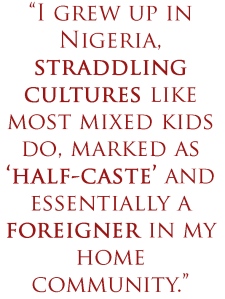
Both my parents loved reading and made sure I had a constant supply of books as a child growing up in Aba. Most of these books were written by authors such as Enid Blyton and C.S. Lewis, and they all featured white children as the characters. Therefore, when I started writing books as a child (here’s one of them), all the people I created in my make believe worlds were also white and with Western names, even though I was born and raised in a deeply Igbo region of Nigeria. The books I’d read were the usual portal into other realities, which I ruthlessly applied to my childhood, convinced that pixies lived in the patch of grass in front of our house and that fairies filled my bedroom, entertained by my sister and I playing. It was easier to fit into these imaginary places.
My love for speculative fiction developed from this, and the chance to develop a fantasy world for the New Visions Award was a perfect match for me. I actually wrote Somadina specifically for this award after I found out about it, penning down a few chapters to meet the submission deadline and drawing heavily from Igbo culture and history to craft a world that I would have liked a portal to myself. I wrote with young adults in mind and worried that perhaps some elements of the story would be a little too dark, but I kept reminding myself that the reality for many young adults of color is that they are likely to personally witness or experience the ‘dark’ themes that are present in my narrative. I had to stay true to the story and tell it the way it was insisting on being told.
All in all, I’m deeply honoured to be a finalist with all these other amazing writers, and extremely grateful to Tu Books for its existence and for this opportunity.
Akwaeke Zara Emezi is an Igbo and Tamil writer who was born and raised in the south of Nigeria. She started writing at five and in the succinct words of her seven year old self- “Her ambition is to be a world famous writer and artist. She has a family of 5 and loves art and books. Her hobby is writing.” Akwaeke now lives in Brooklyn and can be found online at www.azemezi.com.
Meet Our Other Two New Vision Finalists
Filed under:
Awards,
Musings & Ponderings,
Tu Books Tagged:
diversity,
New Visions Award,
Power of Words,
Race issues,
Science Fiction/Fantasy,
Teens/YA,
Tu Books,
writing contests 


By:
Hannah,
on 2/19/2013
Blog:
The Open Book
(
Login to Add to MyJacketFlap)
JacketFlap tags:
Awards,
writing contests,
diversity,
Science Fiction/Fantasy,
Power of Words,
Musings & Ponderings,
Race issues,
Tu Books,
Teens/YA,
New Visions Award,
Add a tag
 Last month we announced the finalists of our first New Visions Award, a new writing award for a debut author of color for a middle grade or young adult science fiction, fantasy, or mystery novel. Over the next few weeks, we’ll be highlighting these talented finalists on our blog as they answer questions about what inspires them, the writing process, and more. Perhaps among these five finalists you’ll find your next favorite author!
Last month we announced the finalists of our first New Visions Award, a new writing award for a debut author of color for a middle grade or young adult science fiction, fantasy, or mystery novel. Over the next few weeks, we’ll be highlighting these talented finalists on our blog as they answer questions about what inspires them, the writing process, and more. Perhaps among these five finalists you’ll find your next favorite author!
Q: What brought you to Tu Books and to the New Visions Award competition in particular?
Ailynn Knox-Collins. Redmond, WA:
I came across Tu Books when I bid on a copy of Tankborn for a charitable cause. Soon after, I had the good fortune to sit next to the writer, Karen Sandler, at an SCBWI conference in LA. I was delighted to find an imprint that is dedicated to putting books out there that are written by and feature characters of color.
Why is it important, you say, that there be this need to highlight multi-ethnic writers and stories? Because to me the world is colorful and always has been, but many of the books I love haven’t always reflected it. Too much of my own childhood was spent thinking that to be a hero or heroine, I had to look a certain way, and mostly not like me. Yet, when I look at the amazing people in the world I grew up in, they came from all sorts of backgrounds, colors and cultures.
So I had to be a part of this endeavor and I congratulate Tu Books on their first ever New Visions Award. I submitted my science fiction story and (wow!) now I’m a finalist. The other finalists are remarkable writers from excitingly varied backgrounds. I am honored to be in this group with them.
I’m a person of mixed ethnicity. My Chinese mother married an Englishman at a time when that act alone could get you disowned by your 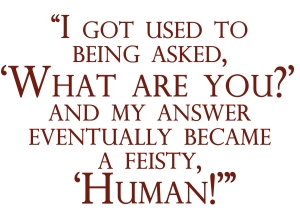 family. I grew up in several countries from England to Singapore. As a child I had my hair stroked by strangers (“Interesting color.”), my nose pinched (“Your ‘bridge’ is so high” or “flat” depending on the country) and my eyes commented on (“Ooh! Double lids.”). I got used to being asked, “What are you?” and my answer eventually became a feisty, “Human!”
family. I grew up in several countries from England to Singapore. As a child I had my hair stroked by strangers (“Interesting color.”), my nose pinched (“Your ‘bridge’ is so high” or “flat” depending on the country) and my eyes commented on (“Ooh! Double lids.”). I got used to being asked, “What are you?” and my answer eventually became a feisty, “Human!”
When I began writing seriously a decade ago, my fictional worlds reflected how I see the real world. My characters naturally look like people I’ve encountered in my life, and they are of all colors. In GENERATION ZERO, my entry to the New Visions Award, everyone happens to be of mixed ethnicity for a horrid, sinister reason — “Mixed breeds are sturdier, like mongrel dogs”. Strangely, someone actually said that to me long ago. Astonishing, isn’t it?
I am so excited to play a small part in bringing attention to something that has been close to my heart for so long. I fell in love with books the day a teacher sat our class under the shade of a giant Raintree and read to us from CS Lewis’ The Lion, The Witch and The Wardrobe. I longed to be one of the Pevensies, but I couldn’t ignore the fact that they, and many subsequent heroines I loved, looked nothing like me. I did my best to ignore descriptions, but I couldn’t help feeling left out. If, as a writer, I can make one child imagine herself the heroine of a story, and know that nothing, especially not the color of her skin, can stop her from achieving her dreams, then I will be satisfied and incredibly humbled.
Well done, Tu Books for your vision and congratulations to all the finalists of the New Visions Award.
Ailynn Knox-Collins is a mother and teacher, as well as a ‘crazy dog lady’ with four great rescues who slobber all over the furniture (well, what else is it for anyway). She is an unashamed Trekkie and is learning to speak Klingon to add to the other 6 languages she already speaks. She loves to read everything and has been inspired to write science fiction so that young people today can experience the same wonder she did growing up. Please visit her at www.taknoxcollins.wordpress.com and follow her on Twitter @talkc
Valynne E. Maetani, Salt Lake City, UT
Initially, I heard about Tu Books when it was still Tu Publishing, and I was ecstatic about its mission . . . and a little dismayed that I didn’t think my book qualified for submission. At the time, I thought they were only interested in fantasy and sci-fi. While my book had a fantasy fairy-tale element, it would definitely be classified as a mystery.
Imagine how excited I was when I heard about the New Visions Award given to a fantasy, sci-fi, or mystery novel. Unfortunately, it was three weeks before the submission deadline. With so little time and a manuscript in dire need of revisions, I realized I couldn’t make it. 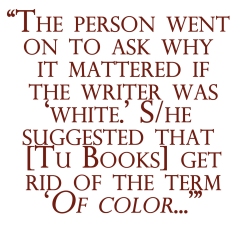
Determined to support their mission, I told myself I would send a manuscript in through their regular submission process at some later date.
But then someone replied to the announcement for the award with the following response: “I was slightly concerned to see that this publisher was seeking submissions for a contest, but only from writers ‘of color’ . . . It appears that the means to the laudable end of ‘true diversity’ in YA/MG lit is more submissions by ‘authors of color.’” The person went on to ask why it mattered if the writer was “white.” S/he suggested they get rid of the term “of color” from all the fine print of their website.
I am the first to say that I have read many wonderful books, with diverse characters, written by authors who are not “of color”—books that were meaningful and shed light on different cultures such as The Good Earth by Pearl Buck or Under the Blood Red Sun by Graham Salisbury. But to me, underrepresented voices are just as important. This award matters. I am a Japanese-American writer, who grew up in Utah, surrounded by people who looked nothing like me, reading books about people who looked nothing like me. I am an author of color. Our voices matter.
And so I worked hard to get my chapters ready for submission.
I truly appreciate that Tu Books seeks to encourage diversity in children’s literature as well as diversity in the authors who write these books. I am humbled and awed by the talent of the other New Visions Award finalists, and I am proud to have my name listed with theirs.
Valynne E. Maetani received a BA from the University of Pennsylvania. She has managed script editing for stories for disadvantaged youth and has edited several screenplays, including My Little War in Juarez, the winner of the 2010 Creative World Award. She can be found at www.valynne.com and on Twitter @valynnemaetani
Stay tuned tomorrow for part II as we hear from our other three finalists!
Filed under:
Awards,
Musings & Ponderings,
Tu Books Tagged:
diversity,
New Visions Award,
Power of Words,
Race issues,
Science Fiction/Fantasy,
Teens/YA,
Tu Books,
writing contests 

This Sunday is Chinese New Year and that means firecrackers, food, and family! You can greet someone by saying Gong Xi Fa Cai (Mandarin) or Gung hay fat choy (Cantonese), which means “wishing you prosperity in the coming year.”
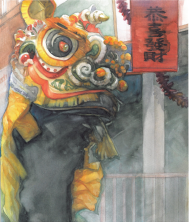
From Sam and the Lucky Money
Chinese New Year is based on the lunar calendar (the moon’s orbit around the Earth), therefore the actual day varies year to year. Many families will prepare for the new year by cleaning the house, shopping for new clothes, buying food to prepare new year meals, and stocking up on red envelopes to put lucky money in. Once the new year arrives, celebratory events continue for the next 15 days, including parades, feasting, red lanterns, and red paper cutouts and calligraphy.
One of the most exciting (and noisy!) activities is the firecrackers. According to old Chinese mythology, there was a mythical beast called Nian who terrorized villages and ate their livestock and crops on the first day of the New Year. One year, villagers noticed Nian running away from a child wearing red, and they realized that Nian was afraid of the color red. That is why the color red is used during Chinese New Year. Firecrackers are used to scare away Nian.
2013 will be the Year of the Snake. People born under this sign are thought to be very intuitive and insightful, and they tend to approach problems rationally and logically. There are 12 animals in the Chinese zodiac, starting with the Rat and ending with the Pig. The legend of the Chinese Zodiac began long ago with the Jade Emperor. He wanted a way to measure time, so he told all the animals on Earth that there would be a swimming race.
The first twelve animals to cross the river would have a year of the zodiac named after them. The Rat and the Cat were scared they wouldn’t make it, but being the clever animals that they were, they asked the Ox if they could ride across on his back and the Ox agreed. Just as they were approaching the finish line, the Rat pushed the Cat into the river and jumped off the Ox’s back to race toward the finish line. This is why the Rat is the first animal in the zodiac and it also explains why cats hate rats and always chase them.

From Amazing Faces
We wish everyone a joyous and prosperous 2013! Check out this heartwarming story to keep the Chinese New Year celebration alive!
Further reading:
What does Ramadan celebrate?
What is Diwali?
Filed under:
Holidays,
Musings & Ponderings Tagged:
Asian/Asian American,
Chinese New Year,
holidays 

A guest post by Summer of the Mariposas author Guadalupe Garcia McCall.
I’ve been travelling to the Rio Grande Valley in South Texas a lot these days, visiting with some wonderful librarians, sharing my story with some amazing students, and just enjoying the adventures this burgeoning writing life is affording me.
Road trips have always been a meditative time for me, a time to be thankful for the blessings in my life and ponder the rest. I listen to the silence of the road, look at the scenery, and engage in prayer. Lately, I’ve been thinking a lot about being an author and wondering if this is going to be my next career, if I will be fortunate enough to have more books published. Not that I am doubting myself, no, it is more that I am feeling so privileged I don’t want to lose myself in the awesomeness of it all. I don’t want to let it go to my head. I want to always remain true to myself, my culture, and my faith.
Last week, as we were en route to Edinburg, I was looking out of my car window, asking for a sign, when quite literally there it was, a sign—a small billboard on the side of the road indicating the location of The Shrine of Don Pedrito Jaramillo, a Texas historical landmark.
Don Pedrito was a curandero, a healer, who was buried on the outskirts of Falfurrias, Texas in 1907. He came from Jalisco, Mexico, and got so sick he couldn’t sleep for days. He cured himself by applying mud to his injured nose and was finally able to get some much needed rest. It was while he slept that God spoke to him and told him he had to help heal the sick. Tales of his miraculous healings abound within the Hispanic community, and so I told my husband we absolutely had to stop.
 So we visited the shrine and a sweet lady helped me pick the perfect candle, la vela de Santa Lucia—for personal elucidation. I lit my candle, gave thanks for this wonderful new writing career, and prayed for guidance and clarity as I embark on this path. That’s when it happened: I received a visit from a most unexpected guest.
So we visited the shrine and a sweet lady helped me pick the perfect candle, la vela de Santa Lucia—for personal elucidation. I lit my candle, gave thanks for this wonderful new writing career, and prayed for guidance and clarity as I embark on this path. That’s when it happened: I received a visit from a most unexpected guest.
It occurred just as I was about to get back in my car, when my husband stopped me and said, “Be careful, you almost closed the door on that butterfly.” I looked at the door’s edge, and there she was, a lovely mariposa. Not just any mariposa, but a brown winged, dark-speckled, many-eyed mariposa. A visitor with a message to deliver.

The Aztecs believed that mariposas were the souls of their loved ones come back to visit them, to bring tidings of hope, and to reassure them that life, however brief, is beautiful. I firmly believe that mariposa was the spirit of my mother who came to remind me that she is with me on this journey, that her loving eyes are always upon me. That I have nothing to worry about because I am being taken care of—that she along with many others are “looking out” for me.
My lovely visitor crawled onto my hand, walked up my sleeve, and just sat there, splaying and displaying her brown, many-eyed wings, as I spoke to her. Some minutes later, she sat politely by while I pulled out my phone and took four close-ups of her. Then, when I thanked her for her unexpected, but much welcomed visit, she let go of the fabric of my jacket and just flew away—reminding me that life is an adventure and I should spread my wings and brave the wind with courage and conviction as I rejoice in the abundance of my blessings.
Filed under:
Musings & Ponderings Tagged:
guadalupe garcia mccall,
Latino/Hispanic/Mexican,
Summer of the Mariposas,
Teens/YA,
Tu Books 

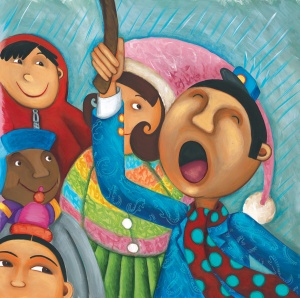
from Iguanas in the Snow and Other Winter Poems
Filed under:
Holidays,
Musings & Ponderings 


By:
Hannah,
on 11/30/2012
Blog:
The Open Book
(
Login to Add to MyJacketFlap)
JacketFlap tags:
dystopia,
Science Fiction/Fantasy,
BookTalk,
author advice,
Musings & Ponderings,
Publishing 101,
Tu Books,
Teens/YA,
diverse energies,
speculative fiction authors,
Add a tag
Before Thanksgiving we had a great chat on Twitter with some of the contributing authors from our new dystopian anthology, Diverse Energies. Authors Cindy Pon, Malinda Lo, Ken Liu, Rahul Kanakia, Rajan Khanna, and K. Tempest Bradford joined us to answer some questions about their stories, dystopia, world-building, and more:
In one or two sentences, can you describe the dystopian worlds you’ve written about in Diverse Energies?
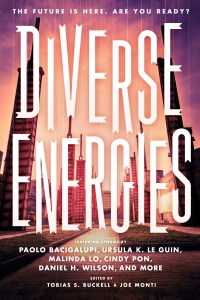
Malinda Lo: “The dystopian world in my story ‘Good Girl’ is a postapocalyptic NYC that politically resembles Communist China.”
Rahul Kanakia: “My story is set in a world where wealthy people have retreated into virtual reality and allowed the world to collapse. Also, there are pesticide-resistant bedbugs.”
Cindy Pon: “‘How had we drifted so far on what it meant to be human?‘ from my story sort of encapsulates it, in a world divided.”
Rajan Khanna: “Mine takes place in a world where an empire similar to the British Empire at its height uses child labor for mining.”
Ken Liu: “‘Pattern Recognition’ is about a school where children are safe. But only later do the children find out its real purpose.”
How did you decide on the specific settings where your stories take place?
Ken Liu: “My story took inspiration from a paper on human-powered computing & news about labor practices of Taiwanese manufacturers.”
Malinda Lo: “I wanted to write a story in a Big City that could be isolated in a disaster, and NYC fit well. As events have shown!”
Rajan Khanna: “I was inspired partly by a story about young kids in South Asia who ruin their bodies to make soccer balls.”
Cindy Pon: “The idea of setting it in Taipei came immediately. I was born there but left at age 6. So many memories are sensory based of Taipei. The city comes at all senses all the time.”
True or false: We are living in a dystopia.
Ken Liu: “I think far more of this planet’s population lives in a dystopia than most of us in the US are willing to acknowledge.”
Rajan Khanna: “I think from a teen standpoint, the world can often seem like a dystopia.”
K. Tempest Bradford: “Some people live in what others would see as a dystopia. It’s often a matter of perspective.”


Are oppressive governments a key part of dystopias?
Rajan Khanna: “For me, I associate that kind of oppression with dystopias. And I think that restriction of freedoms works as a YA theme.”
Malinda Lo: “My idea of ‘dystopian’ is firmly rooted in family stories/experience. I always think of oppressive governments first.”
Ken Liu: “I try to make my dystopias not about the government. I think other things are far more frightening than governments. . . . I think governments are often merely a symptom, not a cause. At least, not the cause.”
If not, are there elements that every dystopia needs?


Since these are short stories, any tips on how to build a world in very few pages?
Malinda Lo: “I think in short stories, world building must be done with some shorthand tricks. Can be hard. Shorthand tricks I like for worldbuilding in stories: food, names, twist on real-world setting that’s easily recognized. I cheated in the story by setting it in post-apoc NYC. Easy to “get”!”
Rahul Kanakia: “Most SF takes place in archetypical worlds: the Orwellian world; the gritty Blade Runner world, etc. The trick is knowing what mental image your reader starts the story with, and knowing how to deviate from that image. Most stories aren’t building worlds; they’re combining worlds that the readers have already ‘seen.’”
What is your favorite short story?
K. Tempest Bradford: “‘Even the Queen’ by Connie Willis. Far future story about menstruation (or lack thereof).”
Rajan Khanna: “‘There Will Come Soft Rains’ by Ray Bradbury.”
Rahul Kanakia: “Jorge Luis Borges’ ‘Library of Babel.’ Not sure the Diverse Energies readers will like it; when I made my students read it, they hated it. More apt example: ‘The Ones Who Walk Away From Omelas,’ by Le Guin.”
Malinda Lo: “Probably ‘The Bloody Chamber’ by Angela Carter.”
Cindy Pon: “Oh gosh. One of Stephen King’s I’m sure.”
You can read the whole chat on Storify.
Filed under:
BookTalk,
Musings & Ponderings,
Publishing 101 Tagged:
author advice,
diverse energies,
dystopia,
Science Fiction/Fantasy,
speculative fiction authors,
Teens/YA,
Tu Books 

Came across a link today to a terrific interview with the late, great Maurice Sendak. Authors and illustrators often wonder what the best way is to deal with negative criticism of their books, so I thought I’d share Mr. Sendak’s first-rate advice:
Interviewer: What kinds of things do children write to you about?
Maurice Sendak: Usually it’s awful, because they don’t feel the urge to write themselves—a few of them do, but usually it’s “Dear Mr. Sendak, Mrs. Markowitz said would you please send a free book and two drawings?” When they write on their own, they’re ferocious. After Outside Over There, which is my favorite book of mine, a little girl wrote to me from Canada: “I like all of your books, why did you write this book, this is the first book I hate. I hate the babies in this book, why are they naked, I hope you die soon. Cordially…” Her mother added a note: “I wondered if I should even mail this to you—I didn’t want to hurt your feelings.” I was so elated. It was so natural and spontaneous. The mother said, “You should know I am pregnant and she has been fiercely opposed to it.” Well, she didn’t want competition, and the whole book was about a girl who’s fighting against having to look after her baby sister.
Interviewer: You find the unvarnished truth consoling, even if it’s vicious and painful.
Maurice Sendak: If it’s true, then you can’t care about the vicious and the painful. You can only be astonished. Most kids don’t dare tell the truth. Kids are the politest people in the world. A letter like that is wonderful. “I wish you would die.” I should have written back, “Honey, I will; just hold your horses.”
You can read the rest of the interview in the November/December 2012 issue of The Believer here.
Filed under:
Musings & Ponderings,
Publishing 101 Tagged:
Advice,
author advice,
illustrator advice 

Don’t forget to vote! The lines may be long, the community centers may be crowded, the ballots may be old fashioned, but it’s a small price to pay for a right many gave their lives for.
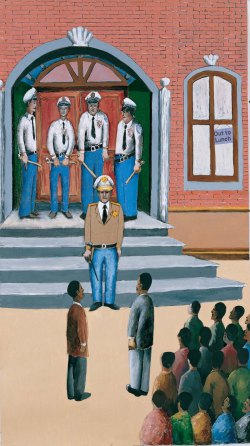
from John Lewis in the Lead
In the words of Lyndon B. Johnson, “A man without a vote is a man without protection.”
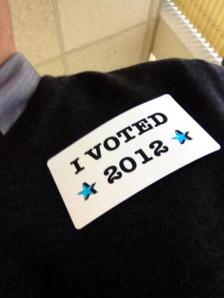
Happy Election Day!
Filed under:
Holidays,
Musings & Ponderings Tagged:
democracy,
voting 


By:
Hannah,
on 10/5/2012
Blog:
The Open Book
(
Login to Add to MyJacketFlap)
JacketFlap tags:
west indies trinidad,
food,
recipes,
Resources,
Caribbean,
Indian,
Southeast Asia,
Musings & Ponderings,
roti,
Add a tag
In this post, our marketing intern Keilin Huang dishes on rotis around the world:
In one of our new LEE & LOW books released this October, Drummer Boy of John John, a young Trinidadian boy named Winston dreams of being in the best band in the Carnival parade, so he can get some of the Roti King’s famous rotis. As Winston puts it, “Carnival jus’ ain’t right without a roti.”
Winston craves these “folded pancakes filled with chicken and secret herbs and spices,” but what exactly is a roti? The word roti means “bread” in Hindi, Urdu, most other North Indian languages, and Malay, and is essentially a round, flat, bread that is cooked on a griddle:
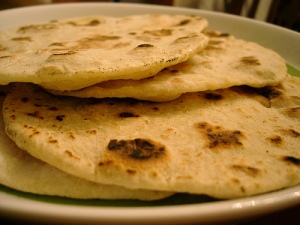
Roti is unleavened, meaning that no rising agents are used, so most recipes involve just mixing water and flour together. Oftentimes, rotis are stuffed with vegetables, meats, curries, or spread with butter.
Roti is a staple in three main regions: India, the West Indies (Trinidad, Tobago, Guyana, and Suriname), and Southeast Asia (Indonesia, Malaysia, and Singapore). In India, roti is often accompanied with cooked vegetables or curries, but it can also be spread with “ghee,” a clarified butter.
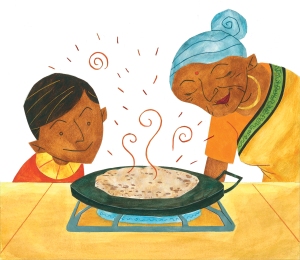
from Hot, Hot Roti for Dada-Ji
Similarly, in the West Indies, rotis are paired with different combinations of vegetables, herbs, and meats. In Drummer Boy of John John, the Roti King is probably making another popular roti called the “wrap roti.” The wrap roti is essentially the same as a normal roti, except it’s folded up with a curry stew inside of it.
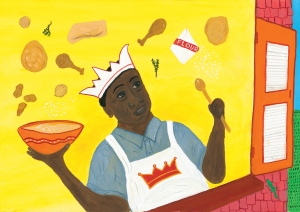
from Drummer Boy of John John
Southeast Asian countries often pair rotis with sauces and stews, using the bread as a dipping tool. And people with a sweet tooth will especially appreciate these rotis with ice cream or “kaya” (a rich, creamy, coconut jam):
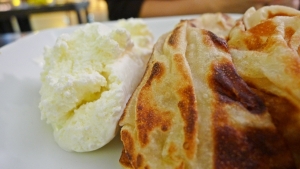
For those of you who are aspiring chefs (or just need something easy and delicious to eat!), here’s a roti recipe for Indian roti from our book Hot, Hot Roti for Dada-Ji. If you want to try Caribbean roti like what Winston eats in Trinidad, try this recipe. And of course, if you have your own family roti recipe, we’d love to hear it!
Filed under:
Musings & Ponderings,
Resources Tagged:
Caribbean,
food,
Indian,
recipes,
roti,
Southeast Asia,
west indies trinidad 

National Hispanic Heritage month occurs each year, from September 15 to October 15. It is a time to celebrate the history and culture of Hispanics and Latinos in the United States along with the contributions they have made to American society.
This specific time of the year was chosen because the U.S government wanted to pay tribute to the Hispanic tradition during a time when many Latin American countries celebrate their independence. September marks the independence anniversaries of Costa Rica, Nicaragua, Guatemala, Honduras, El Salvador, Mexico and Chile.
Lee & Low Books is proud to have many wonderful titles written and illustrated by Latino/a authors and illustrators. Celebrate Hispanic Heritage Month in your own home, classroom, or library with these favorites:
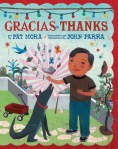
A young boy gives thanks to all that he loves and is thankful for in the lighthearted bilingual celebration, Gracias • Thanks, written by Pat Mora and illustrated by John Parra.
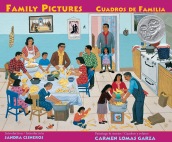
Carmen Lomas Garza’s Family Pictures shows different aspects of the traditional Mexican American culture in which she grew up, including picking cactus and making tamales with her family.

Her second book, In My Family, depicts birthday celebrations, eating empanadas and other fond memories of Carme’s childhood in Kingsville, Texas.
Family Pictures and In My Family are two of the most beloved books published by Children’s Book Press, and we’re thrilled to bring them back into print as part of our CBP imprint!
Filed under:
Holidays,
Musings & Ponderings Tagged:
Carmen Lomas Garza,
hispanic heritage month,
National Hispanic Heritage Month,
Pat Mora,
Rafael Lopez 

A few of us made it out for the Brooklyn Book Festival this weekend, so I thought I’d share a few shots of the event. It was a bright, beautiful fall day, and it was great to see so many people come out to celebrate reading (a record 40,000, according to this article).
Joseph Bruchac, author of Wolf Mark, Buffalo Song, and several other titles, was on a panel about sports stories for boys with Jon Scieszka and Gordon Korman, moderated by Lisa Yee. They were hilarious!
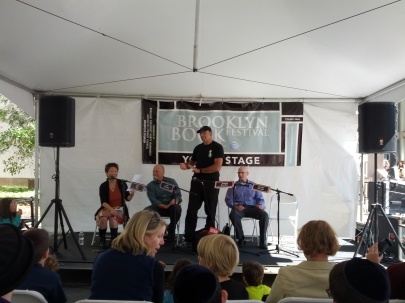
From L: Lisa Yee, Jon Scieszka, Joseph Bruchac, and Gordon Korman
When asked to tell one truth and one lie about himself, Joseph Bruchac offered these two facts:
A.) He once wrestled alligators in high school in upstate NY.
B.) He goes into jails to read/write with criminals, including serial killers.
So, which is true?

The audience guesses were about 50-50, but it turns out that Joe DOES work with a program that brings authors into jails to read and write with inmates. He actually was a wrestler and was asked to wrestle alligators in high school, but turned down the offer because, in his words, “I liked all ten of my fingers.”
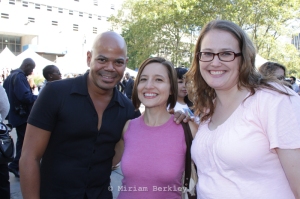
Here’s Tu Books Editorial Director Stacy Whitman (right) with Nora de Hoyos Comstock (center) from Las Comadres, along with an author.
[Sidenote: Las Comadres Para Las Americas is a national organization that connects Latina women. And if you happen to be in the NYC area, their Comadres y compadres Writer's Conference is taking place on October 6 - and our very own Stacy Whitman will be there critiquing manuscripts. If you're an aspiring author, it's a great chance to get feedback on your work.]
From the looks of it, Bird illustrator Shadra Strickland had a pretty good time at the Brooklyn Book Festival this year too. All in all, a lovely day!
Filed under:
Musings & Ponderings,
Tu Books Tagged:
Brooklyn Book Festival,
events,
Joseph Bruchac,
las comadres para las americas,
stacy whitman 


By:
Jaclyn DeForge,
on 9/24/2012
Blog:
The Open Book
(
Login to Add to MyJacketFlap)
JacketFlap tags:
education,
Resources,
Reading Aloud,
critical thinking,
reading comprehension,
Mary Cowhey,
Musings & Ponderings,
common core standards,
Curriculum Corner,
Black Ants and Buddhists,
tolerance,
Add a tag
 Jaclyn DeForge, our Resident Literacy Expert, began her career teaching first and second grade in the South Bronx, and went on to become a literacy coach and earn her Masters of Science in Teaching. In her column she offers teaching and literacy tips for educators.
Jaclyn DeForge, our Resident Literacy Expert, began her career teaching first and second grade in the South Bronx, and went on to become a literacy coach and earn her Masters of Science in Teaching. In her column she offers teaching and literacy tips for educators.
I live in Astoria, Queens, one of the most racially, culturally and ethnically diverse neighborhoods in New York, and my apartment building absolutely reflects that diversity. My neighbors are from Egypt, Bangladesh, and the Dominican Republic and the building is warm and lively, full of immigrant families with young children.
Last week, New York City public schools were closed for Rosh Hashanah, and on Monday, my neighbors’ children played in our building’s courtyard late into the night. My windows were open, and as I sat reading I caught snippets of their conversations as they laughed and ran and screamed and played. But when I stopped and I listened closely, it occurred to me that I kept hearing the same word over and over: the “n-word.”
It was just falling out of their mouths, every other word, as if it were just a synonym for “friend” or “dude.” This saddened me for a couple reasons: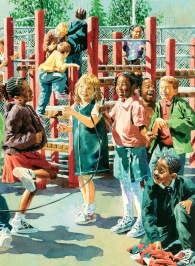
1) For most of the children in my building, English is a second language. I can think of thousands of other words that they should be absorbing and using instead.
2) I also got the sense that the children - being so young and many being first generation Americans, and none of them black - didn’t understand the social and historical implications of the word. They may have known it was a “bad word,” but I would bet they didn’t understand why.
These were not hateful children. These were uninformed children. These were children parroting back a word they’d heard others use without understanding its power. These were children who needed to be taught about the weight of their words.
This got me thinking about the Common Core Standards. Seems like a bizarre leap, but it’s not, really; I’m a huge literacy nerd, and most of my thoughts can be traced back to curriculum.
On page 7 of the introduction, the authors of the Common Core discuss the intentions of the standards, and express that one of the traits of college-/career-ready students is that they come to understand other perspectives and cultures:
Students appreciate that the twenty-first-century classroom and workplace are settings in which people from often widely divergent cultures and who represent diverse experiences and perspectives must learn and work together. Students actively seek to understand other perspectives and cultures through reading and listening, and they are able to communicate effectively with people of varied backgrounds. They evaluate other points of view critically and constructively. Through reading great classic and contemporary works of literature representative of a variety of periods, cultures, and worldviews, students can vicariously inhabit worlds and have experiences much different than their own.
This is huge! In essence, it empowers educators to teach the big things, like tolerance, acceptance, and equality alongside math and science. In addition to teaching comprehension strategies, teachers more than ever can choose books to share with their students that take on some pretty powerful topics and use the literacy block to discuss, debate, respond, investigate and explain.
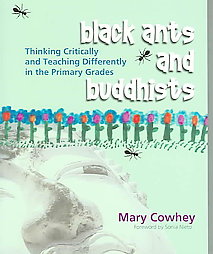 One of my favorite books on curriculum development and educational philosophy around teaching for social justice is Mary Cowhey’s Black Ants and Buddhists: Thinking Critically and Teaching Differently in the Primary Grades. Ms. Cowhey’s strength is her ability to navigate the delicate and difficult social issues and historical topics with young children, weaving it into the fabric of her literacy and social studies curriculum.
One of my favorite books on curriculum development and educational philosophy around teaching for social justice is Mary Cowhey’s Black Ants and Buddhists: Thinking Critically and Teaching Differently in the Primary Grades. Ms. Cowhey’s strength is her ability to navigate the delicate and difficult social issues and historical topics with young children, weaving it into the fabric of her literacy and social studies curriculum.
During one Read Aloud a week, Ms. Cowhey chooses a book that will provoke a philosophical discussion and uses the time to focus on listening and language standards, and peppered throughout the book are the titles of the texts she chooses (not surprisingly, some of the books she mentions are ours!). She includes a powerful chapter entitled “Nurturing History Detectives,” where she talks about how to get children to think critically about perspective when learning history, students that comprehend but can also critique. The Common Core Standards address this need, too:
“Students are engaged and open-minded—but discerning—readers and listeners. They work diligently to understand precisely what an author or speaker is saying, but they also question an author’s or speaker’s assumptions and premises and assess the veracity of claims and the soundness of reasoning.” (also page 7 of the Introduction)
If the idea of teaching tolerance excites you, and I hope it does, I urge you to check out her book. I think it will be an important resource as we make the shift to more rigorous, content/comprehension/critical thinking driven Common Core aligned curriculum.
Filed under:
Curriculum Corner,
Musings & Ponderings,
Resources Tagged:
Black Ants and Buddhists,
common core standards,
critical thinking,
education,
Mary Cowhey,
Reading Aloud,
reading comprehension,
tolerance 


By:
Hannah,
on 9/21/2012
Blog:
The Open Book
(
Login to Add to MyJacketFlap)
JacketFlap tags:
native imagery,
diversity,
good news,
Native American,
racialicious,
whitewashing,
Musings & Ponderings,
Diversity Links,
Race issues,
Add a tag
A lot of the time, discussions about diversity, racial equality, and pop culture can be disheartening. A quick look at Racebending or Racialicious is a good reminder of how far we still have to go when it comes to respecting all cultures, especially in the media. But sometimes, good things happen. People and companies take steps forward. And when that happens, we should talk about it. It’s nice to be able to talk about what people are doing right instead of what they’ve done wrong.
With that in mind, I wanted to share this nice story from the Native Appropriations blog. To make a long story short, the company Paul Frank held a “Dream Catchin’ Pow Wow” party in Los Angeles a few weeks ago for Fashion’s Night Out, with a “Neon-Native American Pow Wow theme” complete with plastic tomahawks, feather headdresses, and a drink called the “Rain Dance Refresher.” On her blog, Adrienne wrote up a post about why the party was so offensive to Native Americans and several others wrote, tweeted, posted, or spoke about it as well.
This story could have had the same sad ending many others have: a half-hearted corporate apology but no real change. Instead, Adrienne got a phone call with the president of Paul Frank Industries, Elie Dekel, so they could discuss what went wrong and how to do better in the future. The company outlined several steps they would be taking to right the wrong, including removing Native-inspired designs from their digital/online imprint, working with a Native artist to make new designs, and collaborating with Adrienne and Beyond Buckskin blogger Jessica Metcalfe on a panel about the use of Native imagery in the fashion industry. You can see more about Paul Frank’s plans here.
It’s really nice to see a conversation about the appropriation of Native culture have such a positive outcome. Congratulations to Adrienne, and kudos to Paul Frank for stepping up, apologizing, and earnestly looking for a way to do better.
In other positive news, check out this handsome guy who was cast as Magnus in the upcoming Mortal Instruments movie based on the YA novel by Cassandra Clare:

In this Tumblr post, Clare describes why she was adamant that Magnus be cast as Asian. So many characters of color have been whitewashed in the book-to-movie transition; I’m glad to see that Magnus isn’t one of them.
Happy Friday!
Filed under:
Diversity Links,
Musings & Ponderings Tagged:
diversity,
good news,
Native American,
native imagery,
Race issues,
racialicious,
whitewashing 

Our marketing intern, Maryann Yin, explores the origins of the word “Dummy”:
When we first read Silent Star, William “Dummy” Hoy’s nickname perplexed many Lee & Low staff members. We found it strange that the celebrated baseball player embraced the nickname “Dummy.” Shouldn’t he feel hurt by it?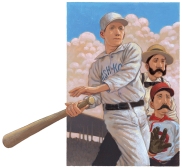
I went on a fact-finding mission to work out this mystery by turning to the Merriam-Webster dictionary. Here are three different definitions for “dummy”:
1. A person who is incapable of speaking.
2. A person who is habitually silent.
3. A stupid person.
In the 21st century, it has become common practice to use “dummy” with insulting intentions. It’s not surprising that some people may feel confused about why William encouraged people to call him “Dummy.” In this passage from Silent Star, author Bill Wise offers an explanation:
“Today calling a deaf person dumb would be derogatory and offensive, but in Hoy’s day it was acceptable. Hoy carried his nickname with pride. Dummy became the name he preferred, and he often corrected people who called him William.”
William was born in 1862. By then, some version of the word “dumb” had existed within the English language for hundreds of years and meant, “silent, unable to speak.” As English became influenced by German, the definition of “stupid” was also adopted; this occurred in the 1800’s.
Today, synonyms for “dummy” include “airhead,” “dimwit” and “idiot.” Under conventional circumstances, those words don’t promote positive feelings for anyone within society, much less those who are deaf. As a result, the deaf community no longer uses the word “dummy.” They have also acquired a much more negative view towards the terms “deaf-mute” and “deaf and dumb,” especially since most people who are deaf can learn how to speak.
With this mystery solved, let’s embark on a new mission to embrace each other by remembering to choose our words carefully.
Filed under:
Musings & Ponderings Tagged:
baseball,
Deaf culture,
Power of Words,
Silent Star 

Today is International Day of the World’s Indigenous Peoples! According to the United Nations, the theme this year is “Indigenous Media, Empowering Indigenous Voices.” It’s nice to see indigenous groups being recognized not as ancient civilizations or oppressed minorities, but as powerful, modern communities actively working to shape their futures. To that end, I came across this video from the BBC and thought it was pretty cool:
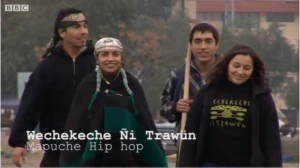
Mapuche Rap – click through to view
What a way to preserve language!
Filed under:
Musings & Ponderings Tagged:
indigenous culture,
Latino/Hispanic/Mexican,
Native American,
Power of Words,
videos 

In this guest post by Vodník author Bryce Moore, Bryce continues to share his favorite things to see, do, and eat when visiting Slovakia.
What to See
In my last post, I gave a rundown of some of Slovakia’s best castles. But Slovakia’s more than just castles:
Bratislava is the capital of the country. It’s a gorgeous old city, and it’s only 45 minutes away from Vienna–they make excellent cities to tour together. Bratislava has much of the same refined culture that you see in Vienna, but it’s at a fraction of the price. (I once went to the state opera and got box seats for $4. Prices have gone up significantly since then, or course.) Check out the markets in the old square, where craftsmen from around the area come together each day to sell their wares. Great stuff.

Tatra Mountains, Slovakia
Banska Stiavnica is a fascinating old mining city. It’s a drive to get there, but once you arrive, you find a city that’s essentially been left alone for the last few hundred years. (One of the tragedies of many places in Slovakia is that Communists made it a point to tear down or change a lot of the historical landmarks. Banska Stiavnica must not have been deemed important enough to warrant Communist attention.) It’s got mines that are over 700 years old, a series of reservoirs, fantastic old churches–and some of the steepest hills I’ve walked up and down. Bring your hiking shoes! (And make sure to check out the Chateau in St. Anton, a town right next to the city. It’s honestly better than any of the attractions I went to in Vienna. Much more authentic—it really gives you a sense of how the Hapsburgs lived.
If you’re more into nature and the outdoors, head north into the Tatra Mountains. Great skiing, rugged mountains, beautiful streams. You’re set no matter when you visit. Just be ready for not a lot of civilization, and a whole lot of green.
Or, to see how life used to be in Slovakia a long time ago, check out Cicmany. Practically the whole village is an example of folk architecture.
What to Eat

If you’re anything like me, no trip is complete without sampling all the goodies you can get your hands on. Slovakia has plenty of great things to eat. One of the most traditional dishes is halusky–basically potato dumplings with cheese and bacon sauce. Absolute heaven. Their bread is fantastic–go into any bakery and just get a sampling of all they’ve got in there. (Better not be on a carb diet!) I’m also a huge fan of their bacon and spiced sausages. Then again, I’m a fan of bacon and spiced sausages, period. For sweets, try wafer cookies and, of course, ice cream. European ice cream blows American ice cream away. Much richer and smoother.
What to Remember
That’s a quick rundown of some of the highlights. To end, I just wanted to add a few cautions. First up, English isn’t spoken as much as you’d like it to be in the country. A lot of the youth speak it (though they’re naturally a bit intimidated at times, talking to native speakers), but many of the tours will be Slovak-only. They do offer English translations of the tours, typically on pieces of paper you can take around with you to read while the tour is going on, but be prepared to be confused sometimes. That said, most Slovaks I’ve met are very welcoming, and more than happy to work with you to help you get what you want or get to where you want to go.

Bratislava
Second, the country’s infrastructure is not yet up to par with what you might be used to here in the States. The highways don’t connect everywhere yet, and many times, the only way you can get somewhere is by taking smaller roads. Then again, the public transportation is great. You don’t need a car in Slovakia. You can take the bus or train most places you want to go. In fact, public transportation is often a great idea from a financial perspective, too, since gas is really expensive – somewhere around $9/gallon.
If you’re flying into the country, your best bet is Bratislava airport, or perhaps Vienna. You can also fly into Prague and drive, but that’s a good three or four hour trip. Slovakia is part of the EU, so they use the Euro. While most of Europe is pretty expensive compared to America, Slovakia’s prices are still very reasonable these days.
And . . . that about sums it up. I love the country, and I hope more people discover it soon. If you’re going and have some specific questions, shoot me an email or send a tweet my way at @bmoorebooks. I’m happy to help how I can. And if you want a better idea of what it’s like living in Slovakia from an American perspective, give Vodník a read through.
Happy trails!
Filed under:
Holidays,
Musings & Ponderings,
Tu Books Tagged:
Science Fiction/Fantasy,
Slovakia,
Travel,
Tu Books,
Vodnik 

View Next 25 Posts
 Last month we brought together past New Voices Award winners to see what it was like to publish their first books. Today, in our final installment in the series, we ask these talented authors to share what they have been doing since entering the contest.
Last month we brought together past New Voices Award winners to see what it was like to publish their first books. Today, in our final installment in the series, we ask these talented authors to share what they have been doing since entering the contest. ![]()
 Linda Boyden, The Blue Roses (our first New Voices Award Winner)
Linda Boyden, The Blue Roses (our first New Voices Award Winner) Paula Yoo, Sixteen Years in Sixteen Seconds: The Sammy Lee Story
Paula Yoo, Sixteen Years in Sixteen Seconds: The Sammy Lee Story Glenda Armand, Love Twelve Miles Long
Glenda Armand, Love Twelve Miles Long Don Tate, It Jes’ Happened: When Bill Traylor Started to Draw
Don Tate, It Jes’ Happened: When Bill Traylor Started to Draw Jennifer Torres, Finding the Music (2011 New Voices Winner)
Jennifer Torres, Finding the Music (2011 New Voices Winner)









































 So we visited the shrine and a sweet lady helped me pick the perfect candle, la vela de Santa Lucia—for personal elucidation. I lit my candle, gave thanks for this wonderful new writing career, and prayed for guidance and clarity as I embark on this path. That’s when it happened: I received a visit from a most unexpected guest.
So we visited the shrine and a sweet lady helped me pick the perfect candle, la vela de Santa Lucia—for personal elucidation. I lit my candle, gave thanks for this wonderful new writing career, and prayed for guidance and clarity as I embark on this path. That’s when it happened: I received a visit from a most unexpected guest.



























I forgot to add, I also got the chance to meet up with a Korean librarian while I was in Korea. It’s always so much fun to listen to different perspectives and learn about how children’s literature and librarianship works in another country, and Korea’s system (all librarians are employed by the federal government, for example, if I understood her right) was fascinating to hear about.